注:笔记 来自课程 Python+OpenCV计算机视觉
Tips①:只是记录从这个课程学到的东西,不是推广、没有安利
Tips②:本笔记主要目的是为了方便自己遗忘查阅,或过于冗长、或有所缺省、或杂乱无章,见谅
文章目录
一、基本操作
1、读取图像
img = cv2.imread("XX.jpg")
img = cv2.imread("XX.jpg", cv2.IMREAD_XXX)
2、展示图像
cv2.imshow("window_name", img)
cv2.waitKey(0)
3、保存图像
cv2.imwrite("XXX.jpg", img)
4、关闭全部窗口
用完cv记得destroyAllWindows
cv2.destroyAllWindows()
二、基本处理
1、访问像素
在img读取了图像后,可用img[]的形式访问相关区域像素值
img_bgr[15, 15] # [168 145 219]
img_bgr[15, 15, 2] # 219
img_gray[15, 15] # 144
img_bgr[15, 15] = [255, 255, 255]
img_bgr[15:45, 15:45] = [255, 255, 255]
此外,也可以通过img.item()获取、通过img.itemset修改像素值
print(f"B:{img_bgr.item(15, 15, 0)}")
print(f"G:{img_bgr.item(15, 15, 1)}")
print(f"R:{img_bgr.item(15, 15, 2)}")
img_bgr.itemset((88, 99, 0), 155)
2、图像属性
形状
img.shape # [400, 400, 3]
像素数
img.size # 480000
图像类型
img.dtype # uint8
3、图像ROI
ROI即感兴趣区域,从被处理的图像以方框、圆、椭圆、不规则多边形等方式勾勒出需要处理的区域。
可以通过切片访问img从而得到ROI区域
示例代码:
import cv2
'''读取图像'''
img1 = cv2.imread("../001.jpg")
img2 = cv2.imread("../002.jpg")
cv2.imshow("img1", img1)
cv2.imshow("img2", img2)
'''ROI区域获取'''
face = img1[50:230, 50:230]
'''观察ROI区域'''
cv2.imshow("face", face)
'''放入另一张图像'''
img2[40:220, 380:200:-1] = face
cv2.imshow("new_img2", img2)
'''关闭窗口'''
cv2.waitKey(0)
cv2.destroyAllWindows()
效果:

4、通道的拆分与合并
拆分通道
b, g, r = cv2.split(img)
合并通道
m = cv2.merge([b, g, r])
三、图像运算
1、图像加法
图像加法分为两种 { 取 模 加 法 p t = ( p t 1 + p t 2 ) % 255 饱 和 加 法 p t = { p t 1 + p t 2 p t 1 + p t 2 ≤ 255 255 p t 1 + p t 2 > 255 \begin{cases} 取模加法 & pt = (pt1 + pt2) \% 255 \\ \\ 饱和加法 & pt = \begin{cases} pt1 + pt2 & pt1 + pt2 \leq 255 \\ 255 & pt1 + pt2 > 255 \end{cases} \\ \end{cases} ⎩⎪⎪⎪⎨⎪⎪⎪⎧取模加法饱和加法pt=(pt1+pt2)%255pt={pt1+pt2255pt1+pt2≤255pt1+pt2>255
取模加法
img1 + img2
饱和加法
cv2.add(img1, img2)
示例代码:
import cv2
'''读取图像'''
img_a = cv2.imread("../001.jpg")
img_b = img_a
cv2.imshow("origin", img_a)
'''取模加法'''
res1 = img_a + img_b
cv2.imshow("res1", res1)
'''饱和加法'''
res2 = cv2.add(img_a, img_b)
cv2.imshow("res2", res2)
'''关闭窗口'''
cv2.waitKey(0)
cv2.destroyAllWindows()
效果:

2、图像融合
图像融合公式: res = img1 ⋅ α + img2 ⋅ β + γ \textbf{res} = \textbf{img1} \cdot \alpha + \textbf{img2} \cdot \beta + \gamma res=img1⋅α+img2⋅β+γ
res = cv2.addWeighted(img1, alpha, img2, beta, gamma)
四、类型转换
OpenCV提供了200多种不同类型之间的转换。
'''BGR→Gray'''
img_gray = cv2.cvtColor(img, cv2.COLOR_BGR2GRAY)
'''Gray→BGR'''
img_bgr = cv2.cvtColor(img_gray, cv2.COLOR_GRAY2BGR)
'''BGR→RGB'''
img_rgb = cv2.cvtColor(img, cv2.COLOR_BGR2RGB)
五、几何变换
1、图像缩放
img_re = cv2.resize(img, (wid, hig))
img_re = cv2.resize(img, None, fx=0.5, fy=0.8)
2、图像翻转
img_res = cv2.flip(img, code)
示例代码:
import cv2
'''读取、展示图像'''
img = cv2.imread("../001.jpg")
cv2.imshow("origin", img)
'''图像缩放'''
img1 = cv2.flip(img, 0) # 上下翻转(关于x轴)【flag = 0】
img2 = cv2.flip(img, 1) # 左右翻转(关于y轴)【flag > 0】
img3 = cv2.flip(img, -1) # 上下左右(关于原点)【flag < 0】
cv2.imshow("img1", img1)
cv2.imshow("img2", img2)
cv2.imshow("img3", img3)
'''等待、关闭窗口'''
cv2.waitKey(0)
cv2.destroyAllWindows()
效果:

3、图像平移
仿射变换
res = cv2.warpAffine(img, M, (wid, hig))
仿射原理
res
[
x
,
y
]
=
img
[
M
11
x
+
M
12
y
+
M
13
,
M
21
x
+
M
22
y
+
M
23
]
\textbf{res}[x, y] = \textbf{img}[M_{11}x + M_{12}y + M_{13}, M_{21}x + M_{22}y + M_{23}]
res[x,y]=img[M11x+M12y+M13,M21x+M22y+M23]
图像平移
利用仿射变换,图像平移只需要设置平移矩阵 M = [ 1 0 x 0 1 y ] M = \begin{bmatrix} 1 & 0 & x \\ 0 & 1 & y \\ \end{bmatrix} M=[1001xy]其中, x x x、 y y y 分别为 x x x方向 和 y y y方向 需要平移的像素单位
M = np.float32([1, 0, x], [0, 1, y])
res = cv2.warpAffine(img, M, (wid, hig))
示例代码
import cv2
import numpy as np
'''读取、展示图像'''
img = cv2.imread("../001.jpg")
cv2.imshow("origin", img)
'''平移'''
M = np.float32([[1, 0, 100], [0, 1, 100]])
img1 = cv2.warpAffine(img, M, img.shape[:2])
cv2.imshow("img1", img1)
'''等待、关闭窗口'''
cv2.waitKey(0)
cv2.destroyAllWindows()
效果

4、图像旋转
与图像平移类似,同样需要借助于仿射变换实现
要完成图像旋转,只需要设置旋转矩阵 M = [ α β ( 1 − α ) ⋅ center . x − β ⋅ center . y − β α β ⋅ center . x + ( 1 − α ) ⋅ center . y ] 其 中 , { α = s c a l e ⋅ cos a n g l e β = s c a l e ⋅ sin a n g l e \begin{aligned} &M = \begin{bmatrix} \alpha & \beta & (1 - \alpha) \cdot \textbf{center}.x - \beta \cdot \textbf{center}.y \\ -\beta & \alpha & \beta \cdot \textbf{center}.x + (1 - \alpha) \cdot \textbf{center}.y \end{bmatrix} \\ \\ & 其中, \begin{cases} \alpha = scale \cdot \cos angle \\ \beta = scale \cdot \sin angle \end{cases} \end{aligned} M=[α−ββα(1−α)⋅center.x−β⋅center.yβ⋅center.x+(1−α)⋅center.y]其中,{α=scale⋅cosangleβ=scale⋅sinangle
这样的矩阵可以通过cv的API直接计算获取
retval = cv2.getRotationMatrix2D(center, angle, scale)
示例代码
import cv2
'''读取、展示图像'''
img = cv2.imread("../001.jpg")
cv2.imshow("origin", img)
'''图像旋转'''
rows, cols, chn = img.shape
M = cv2.getRotationMatrix2D((rows // 2, cols // 2), 45, 0.5)
img1 = cv2.warpAffine(img, M, (rows, cols))
cv2.imshow("img1", img1)
'''等待、关闭窗口'''
cv2.waitKey(0)
cv2.destroyAllWindows()
效果

5、仿射变换
res = cv2.warpAffine(img, M, (wid, hig))
要确定一个仿射变换,主要是要确定一个变换矩阵
M
M
M,而这里的矩阵
M
M
M是一个
3
×
2
3 \times 2
3×2的矩阵,根据仿射原理
res
[
x
,
y
]
=
img
[
M
11
x
+
M
12
y
+
M
13
,
M
21
x
+
M
22
y
+
M
23
]
\textbf{res}[x, y] = \textbf{img}[M_{11}x + M_{12}y + M_{13}, M_{21}x + M_{22}y + M_{23}]
res[x,y]=img[M11x+M12y+M13,M21x+M22y+M23]
显然只需要三对点之间的映射关系就可以得到6个方程,从而确定矩阵
M
M
M,以确定仿射变换

这样的矩阵可以通过cv的API直接计算获取
p1 = np.float32([[x1, y1], [x2, y2], [x3, y3]])
p2 = np.float32([[a1, b1], [a2, b2], [a3, b3]])
M = cv.getAffineTransform(p1, p2)
示例代码
import cv2
import numpy as np
'''读取、展示图像'''
img = cv2.imread("../001.jpg")
cv2.imshow("origin", img)
'''仿射变换'''
rows, cols = img.shape[:2]
p1 = np.float32([[0, 0], [rows - 1, 0], [0, cols - 1]])
p2 = np.float32([[rows // 6, cols // 6], [rows - 1, cols // 2], [rows // 2, cols - 1]])
M = cv2.getAffineTransform(p1, p2)
res = cv2.warpAffine(img, M, (round(rows * 1.5), round(cols * 1.5)))
cv2.imshow("res", res)
'''等待、关闭窗口'''
cv2.waitKey(0)
cv2.destroyAllWindows()
效果
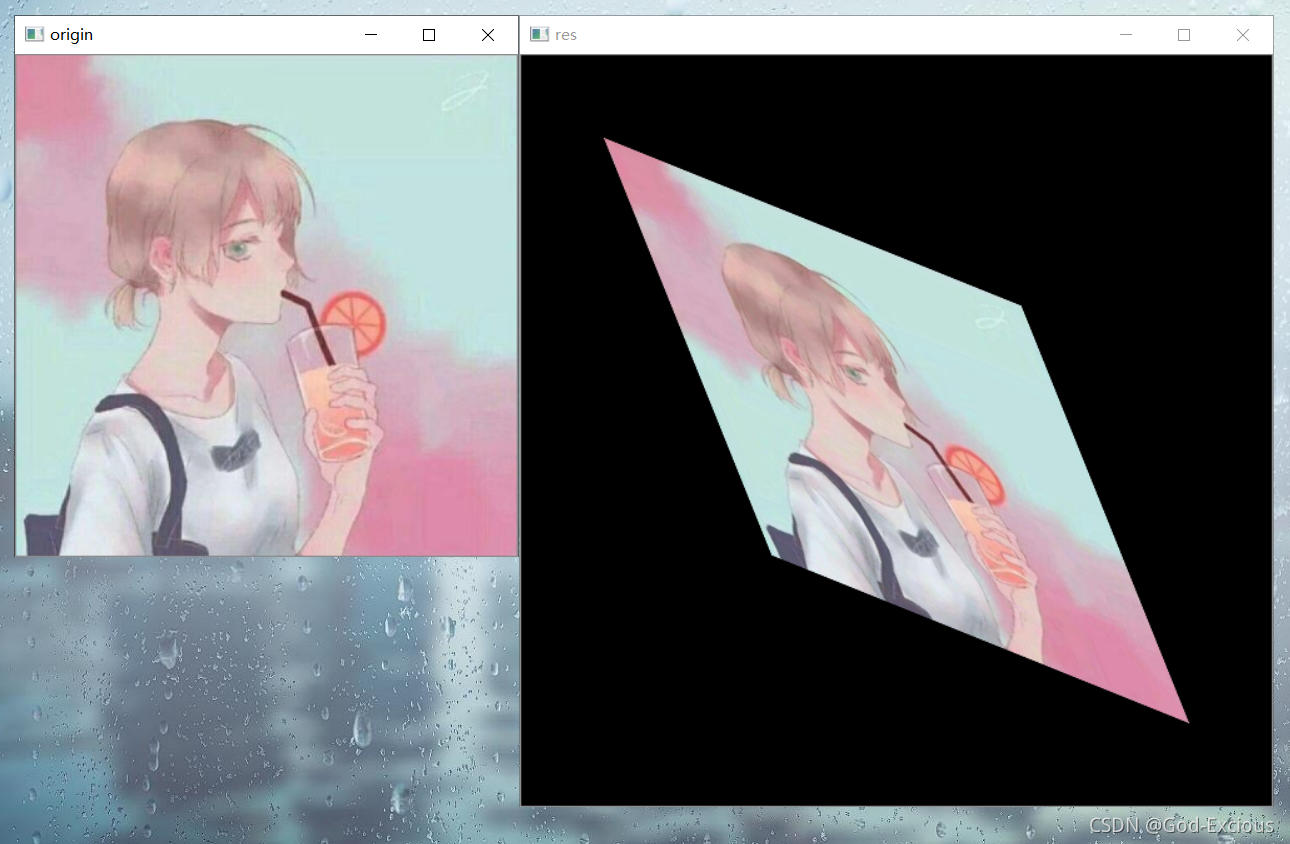
六、阈值分割
1、阈值分割(基本概念)
-
二进制阈值化
超过阈值设置为最大,小于阈值设置为 0 0 0
d s t ( x , y ) = { maxVal s r c ( x , y ) > thresh 0 s r c ( x , y ) ≤ thresh dst(x,y) = \begin{cases} \text{maxVal} & src(x, y) > \text{thresh} \\ 0 & src(x, y) \leq \text{thresh} \end{cases} dst(x,y)={maxVal0src(x,y)>threshsrc(x,y)≤thresh

-
反二进制阈值化
超过阈值设置为 0 0 0,小于阈值设置为最大
d s t ( x , y ) = { 0 s r c ( x , y ) > thresh maxVal s r c ( x , y ) ≤ thresh dst(x,y) = \begin{cases} 0 & src(x, y) > \text{thresh}\\ \text{maxVal} & src(x, y) \leq \text{thresh} \\ \end{cases} dst(x,y)={0maxValsrc(x,y)>threshsrc(x,y)≤thresh

-
截断阈值化
大于等于阈值设置为阈值,小于阈值保持不变
d s t ( x , y ) = { threshold s r c ( x , y ) ≥ thresh s r c ( x , y ) s r c ( x , y ) < thresh dst(x,y) = \begin{cases} \text{threshold} & src(x, y) \geq \text{thresh}\\ src(x, y) & src(x, y) < \text{thresh} \\ \end{cases} dst(x,y)={thresholdsrc(x,y)src(x,y)≥threshsrc(x,y)<thresh

-
反阈值化为0
大于等于阈值设置为 0 0 0,小于阈值保持不变
d s t ( x , y ) = { 0 s r c ( x , y ) ≥ thresh s r c ( x , y ) s r c ( x , y ) < thresh dst(x,y) = \begin{cases} 0 & src(x, y) \geq \text{thresh}\\ src(x, y) & src(x, y) < \text{thresh} \\ \end{cases} dst(x,y)={0src(x,y)src(x,y)≥threshsrc(x,y)<thresh

-
阈值化为0
大于等于阈值保持不变,小于阈值设置为 0 0 0
d s t ( x , y ) = { s r c ( x , y ) s r c ( x , y ) ≥ thresh 0 s r c ( x , y ) < thresh dst(x,y) = \begin{cases} src(x, y) & src(x, y) \geq \text{thresh}\\ 0 & src(x, y) < \text{thresh} \\ \end{cases} dst(x,y)={src(x,y)0src(x,y)≥threshsrc(x,y)<thresh

2、阈值分割(代码实现)
阈值分割
retval, dst = cv2.threshold(src, thresh, maxval, type)
示例代码
import cv2
'''读取图像'''
img = cv2.imread("001.jpg", cv2.IMREAD_GRAYSCALE)
cv2.imshow("origin", img)
'''阈值设置'''
thresh = 175
'''二进制阈值化'''
_, img_thresh_binary = cv2.threshold(img, thresh, 255, cv2.THRESH_BINARY)
cv2.imshow("thresh_binary", img_thresh_binary)
'''反二进制阈值化'''
_, img_thresh_binary_inv = cv2.threshold(img, thresh, 255, cv2.THRESH_BINARY_INV)
cv2.imshow("thresh_binary_inv", img_thresh_binary_inv)
'''截断阈值化'''
_, img_thresh_trunc = cv2.threshold(img, thresh, 255, cv2.THRESH_TRUNC)
cv2.imshow("thresh_trunc", img_thresh_trunc)
'''反阈值化为0'''
_, img_thresh_tozero_inv = cv2.threshold(img, thresh, 255, cv2.THRESH_TOZERO_INV)
cv2.imshow("thresh_tozero_inv", img_thresh_tozero_inv)
'''阈值化为0'''
_, img_thresh_tozero = cv2.threshold(img, thresh, 255, cv2.THRESH_TOZERO)
cv2.imshow("thresh_tozero", img_thresh_tozero)
'''等待、关闭图像'''
cv2.waitKey(0)
cv2.destroyAllWindows()
测试

七、图像平滑处理
作用:可以将图像模糊一些,以去除一些原来图像上明显的噪点
1、均值滤波
这个概念有点类似卷积神经网络里的卷积核
将某个像素周围的像素矩阵和核矩阵展平计算内积,得到一个新的像素值

将整张图像进行这样的操作得到均值滤波后的图像

均值滤波
均值滤波实际上就是将周围的像素值计算平均值
res = cv2.blur(img, (Ksize, Ksize))
示例代码
import cv2
'''读取图像'''
img = cv2.imread("../001.jpg")
cv2.imshow("origin", img)
'''均值滤波'''
res = cv2.blur(img, (5, 5))
cv2.imshow("res", res)
'''等待、关闭图像'''
cv2.waitKey(0)
cv2.destroyAllWindows()
效果

2、方框滤波
方框滤波
res = cv2.boxFilter(img, -1, (Ksize, Ksize), normalize=True) # 求和后求均值(等同均值滤波)
res = cv2.boxFilter(img, -1, (Ksize, Ksize), normalize=False) # 求和(容易溢出)
示例代码
import cv2
'''读取图像'''
img = cv2.imread("../001.jpg")
'''先预处理一下'''
img = cv2.multiply(img, (1, 1, 1, 1), scale=0.36)
cv2.imshow("origin", img)
'''方框滤波'''
res = cv2.boxFilter(img, -1, (2, 2), normalize=False)
cv2.imshow("res", res)
'''等待、关闭图像'''
cv2.waitKey(0)
cv2.destroyAllWindows()
效果

3、高斯滤波
高斯滤波
相当于在均值滤波的基础上增加了权重的概念,可以看做是加权均值滤波
'''
Ksize 必须为奇数
sigmaX X方向方差,控制权重
sigmaX = 0时, sigma = 0.3 * ((Ksize - 1) * 0.5 - 1) + 0.8
'''
res = cv2.GaussianBlur(img, (Ksize, Ksize), sigmaX)
示例代码
import cv2
'''读取图像'''
img = cv2.imread("../001.jpg")
cv2.imshow("origin", img)
'''高斯滤波'''
res = cv2.GaussianBlur(img, (5, 5), 0)
cv2.imshow("res", res)
'''等待、关闭图像'''
cv2.waitKey(0)
cv2.destroyAllWindows()
效果

4、中值滤波
中值滤波
将像素附近、核大小内的元素排序后的中间值作为处理后的相应的像素
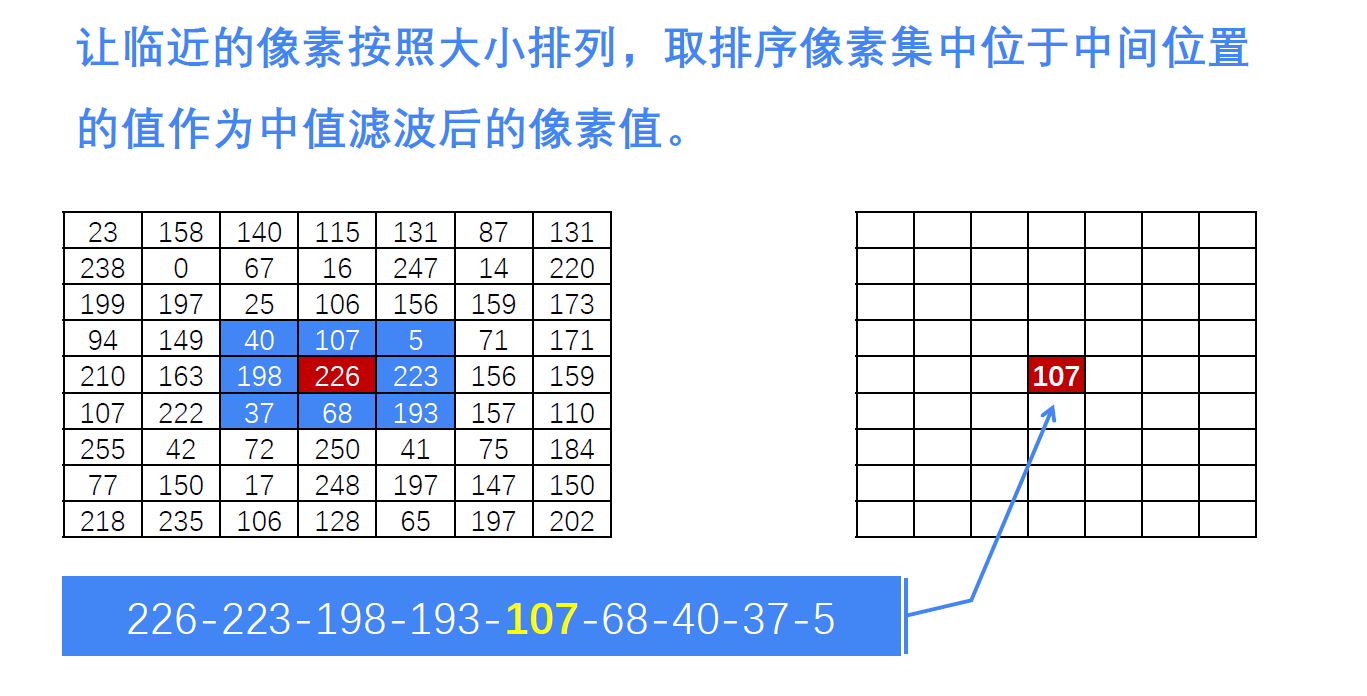
'''
Ksize必须为奇数
'''
res = cv2.medianBlur(img, Ksize)
示例代码
import cv2
'''读取图像'''
img = cv2.imread("../001.jpg")
cv2.imshow("origin", img)
'''中值滤波'''
res = cv2.medianBlur(img, 5)
cv2.imshow("res", res)
'''等待、关闭图像'''
cv2.waitKey(0)
cv2.destroyAllWindows()
效果

5、卷积
卷积
可以看做自定义核的矩阵,进行相关运算
res = cv2.filter2D(img, -1, Kernel)
示例代码
import cv2
import numpy as np
'''读取图像'''
img = cv2.imread("../001.jpg")
cv2.imshow("origin", img)
'''卷积'''
kernel = np.array([[0.05, 0.05, 0.3], [0.3, 0.02, 0.01], [0, 0, 0]]) * 2
res = cv2.filter2D(img, -1, kernel)
cv2.imshow("res", res)
'''等待、关闭图像'''
cv2.waitKey(0)
cv2.destroyAllWindows()
效果

八、形态学处理
1、图像腐蚀
腐蚀
该操作一般针对二值图像
腐蚀操作需要两个输入对象:二值图像、卷积核
基本操作:卷积核遍历图像的一部分,当卷积核内的元素均为1时,结果图像对应位置的像素值才为1,否则为0(腐蚀掉白色的边缘)
如下图所示:

'''
iterations 迭代次数
'''
res = cv2.erode(img, kernel, iterations)
示例代码:
import cv2
import numpy as np
'''读取图像'''
img = cv2.imread("../001.jpg", cv2.IMREAD_GRAYSCALE)
_, img = cv2.threshold(img, 180, 255, cv2.THRESH_BINARY_INV)
cv2.imshow("origin", img)
'''腐蚀'''
kernel = np.ones((3, 3), np.uint8)
res = cv2.erode(img, kernel, iterations=9)
cv2.imshow("res", res)
'''等待、关闭图像'''
cv2.waitKey(0)
cv2.destroyAllWindows()
效果:
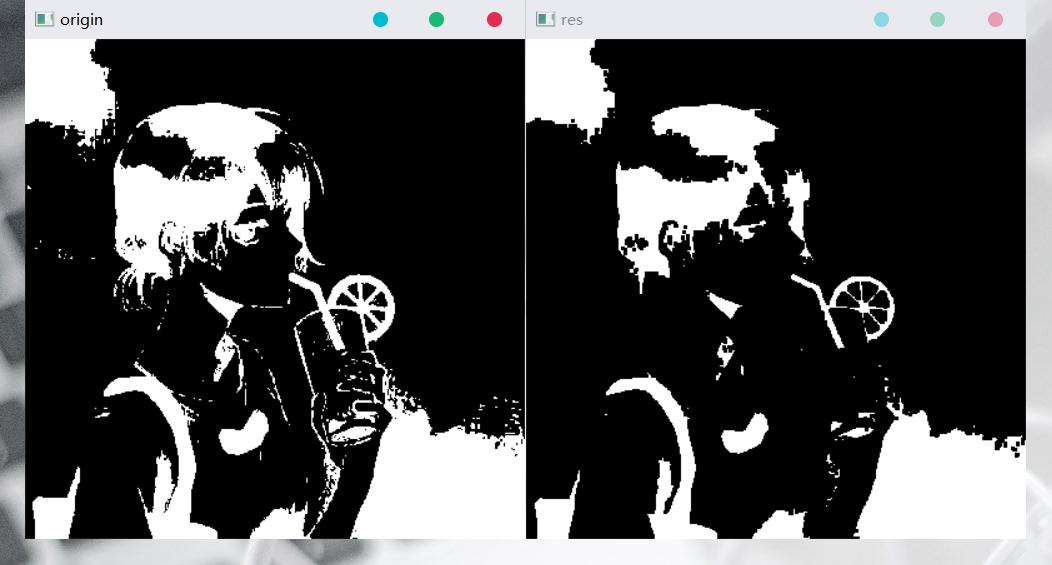
2、图像膨胀
膨胀
腐蚀操作的逆操作(同样针对二值图像,对白色的边缘进行膨胀)
作用:
-
图像被腐蚀后,去除了噪声,但是会压缩图像
-
对腐蚀后的图像,进行膨胀处理,可以去除噪声,并保持原有形状

res = cv2.dilate(img, kernel, iterations)
示例代码:
import cv2
import numpy as np
'''读取图像'''
img = cv2.imread("../001.jpg", cv2.IMREAD_GRAYSCALE)
_, img = cv2.threshold(img, 180, 255, cv2.THRESH_BINARY_INV)
cv2.imshow("origin", img)
'''膨胀'''
kernel = np.ones((3, 3), np.uint8)
res = cv2.dilate(img, kernel)
cv2.imshow("res", res)
'''等待、关闭图像'''
cv2.waitKey(0)
cv2.destroyAllWindows()
效果:
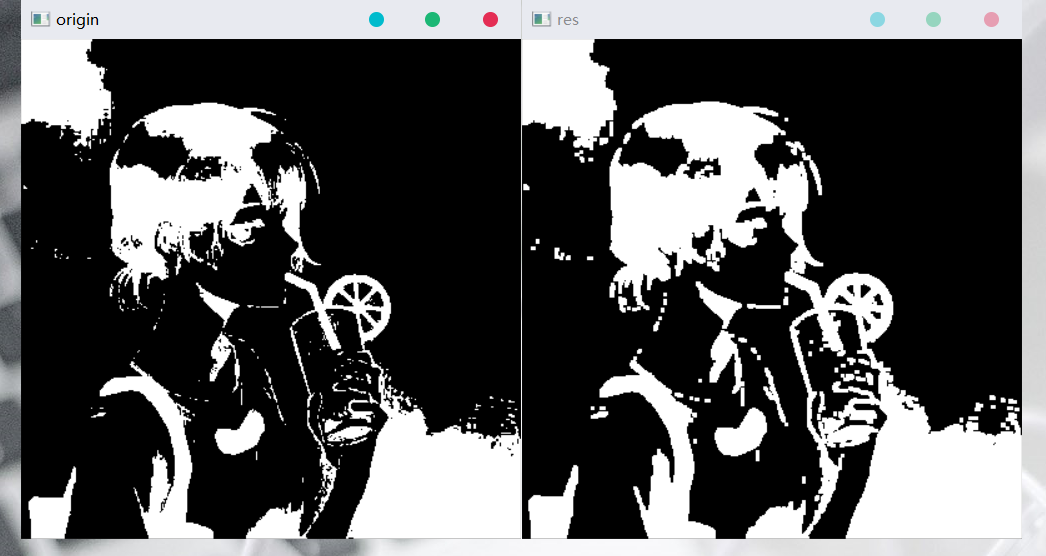
3、开运算
开运算
开运算的操作就相当于对图像先进行腐蚀再进行膨胀
开运算有助于去除图像的噪声
可以使用形态学扩展的API来实现开运算
res = cv2.morphologyEx(img, cv2.MORPH_OPEN, kernel)
示例代码:
import cv2
import numpy as np
'''读取图像'''
img = cv2.imread("../001.jpg", cv2.IMREAD_GRAYSCALE)
_, img = cv2.threshold(img, 180, 255, cv2.THRESH_BINARY_INV)
cv2.imshow("origin", img)
'''开运算'''
kernel = np.ones((3, 3), np.uint8)
res = cv2.morphologyEx(img, cv2.MORPH_OPEN, kernel)
cv2.imshow("res", res)
'''等待、关闭图像'''
cv2.waitKey(0)
cv2.destroyAllWindows()
效果:

4、闭运算
闭运算的操作就相当于对图像先进行膨胀再进行腐蚀
闭运算有助于去除图像的内部的小孔、小黑点
可以使用形态学扩展的API来实现闭运算
res = cv2.morphologyEx(img, cv2.MORPH_CLOSE, kernel)
示例代码:
import cv2
import numpy as np
'''读取图像'''
img = cv2.imread("../001.jpg", cv2.IMREAD_GRAYSCALE)
_, img = cv2.threshold(img, 180, 255, cv2.THRESH_BINARY_INV)
cv2.imshow("origin", img)
'''闭运算'''
kernel = np.ones((3, 3), np.uint8)
res = cv2.morphologyEx(img, cv2.MORPH_CLOSE, kernel)
cv2.imshow("res", res)
'''等待、关闭图像'''
cv2.waitKey(0)
cv2.destroyAllWindows()
效果:
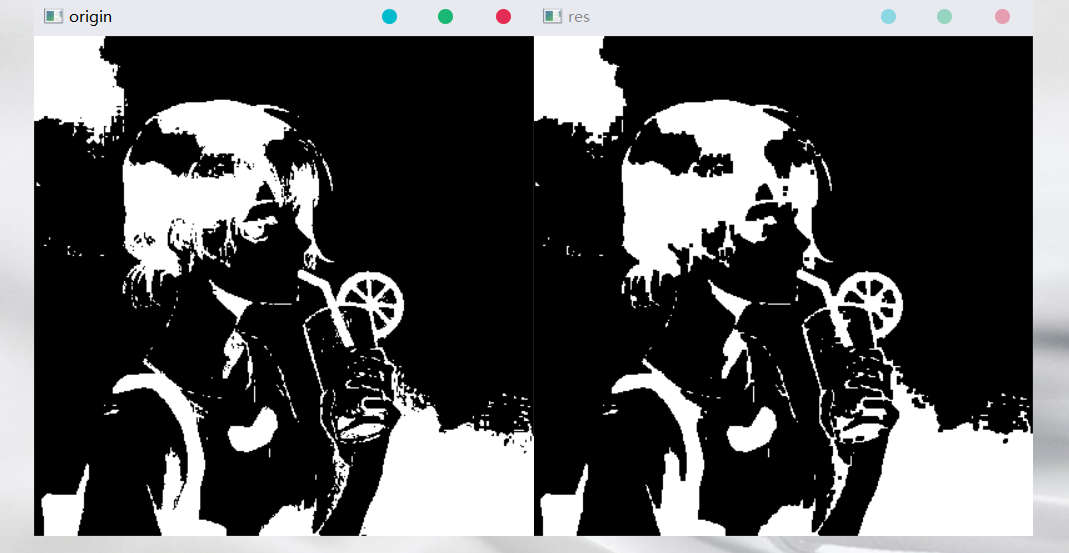
5、梯度运算
梯度运算
梯度运算的操作就相当于用膨胀图像减去腐蚀图像,可以得到图像的边缘信息
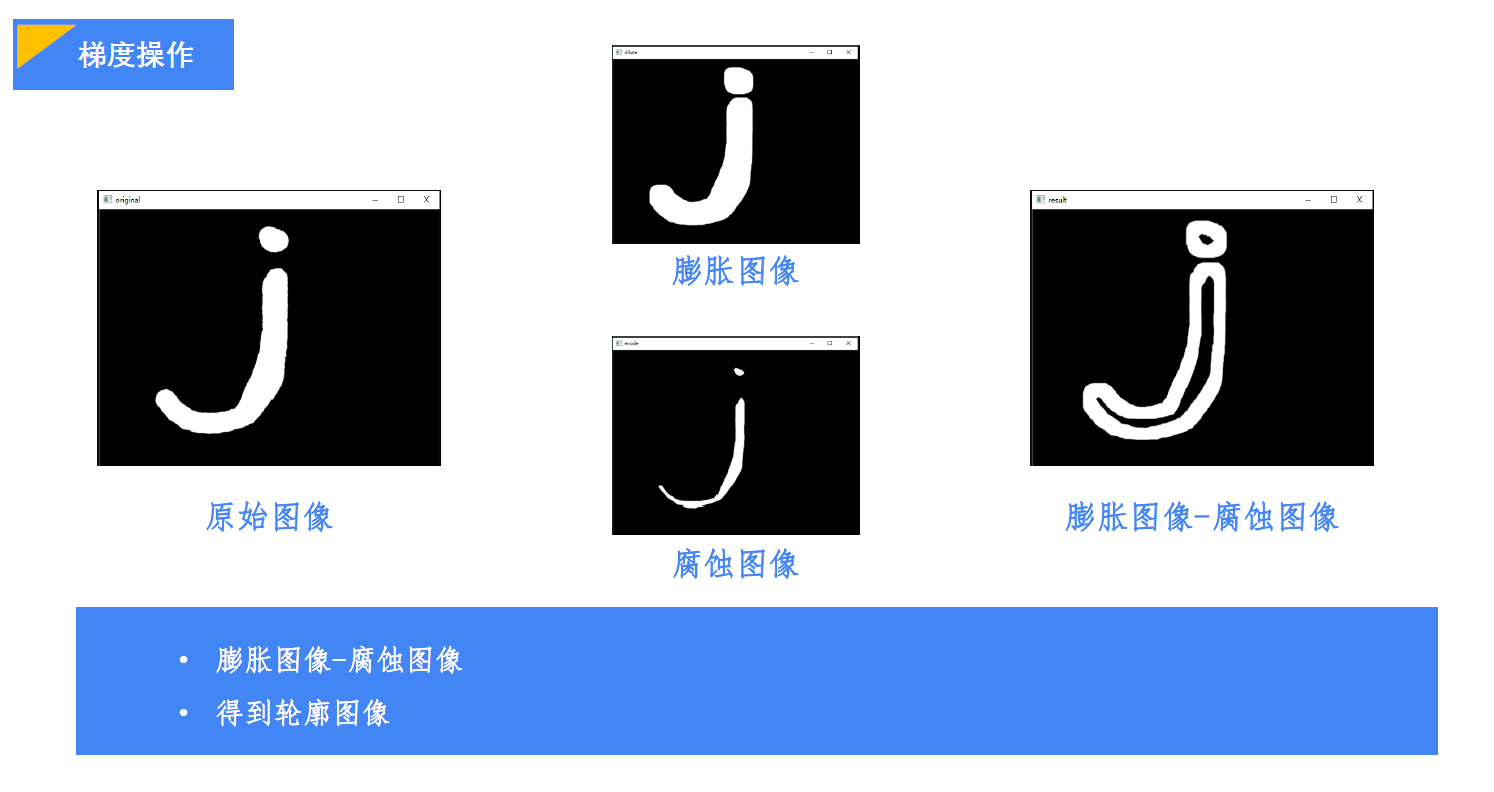
可以使用形态学扩展的API来实现梯度运算
res = cv2.morphologyEx(img, cv2.MORPH_GRADIENT, kernel)
示例代码:
import cv2
import numpy as np
'''读取图像'''
img = cv2.imread("../001.jpg", cv2.IMREAD_GRAYSCALE)
_, img = cv2.threshold(img, 180, 255, cv2.THRESH_BINARY_INV)
cv2.imshow("origin", img)
'''梯度运算'''
kernel = np.ones((3, 3), np.uint8)
res = cv2.morphologyEx(img, cv2.MORPH_GRADIENT, kernel)
cv2.imshow("res", res)
'''等待、关闭图像'''
cv2.waitKey(0)
cv2.destroyAllWindows()
效果:
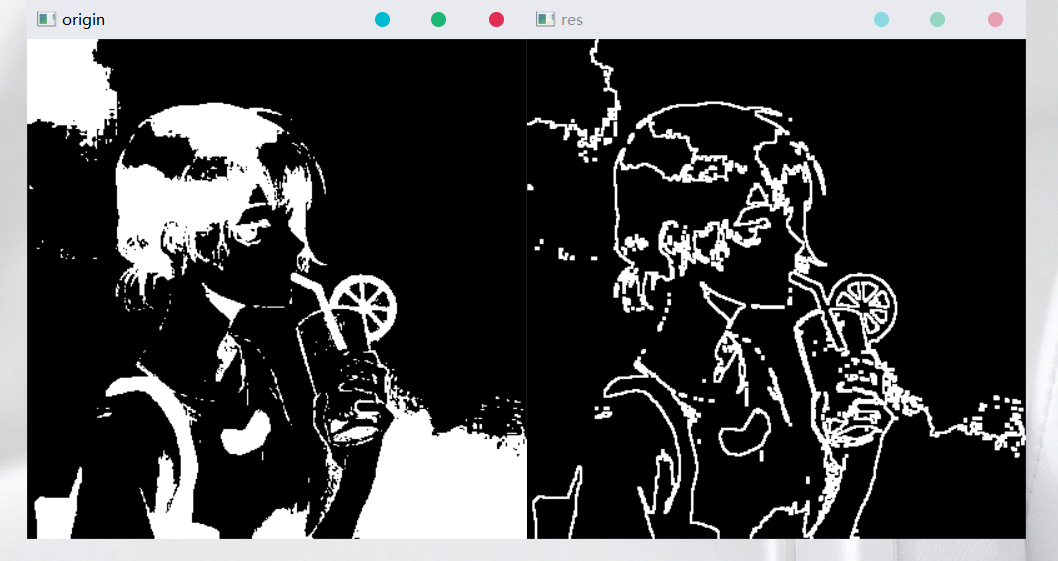
6、礼帽运算(顶帽运算)
礼帽运算
礼帽运算的操作就相当于用原始图像减去开运算图像,可以得到图像的噪声信息(噪声图像)
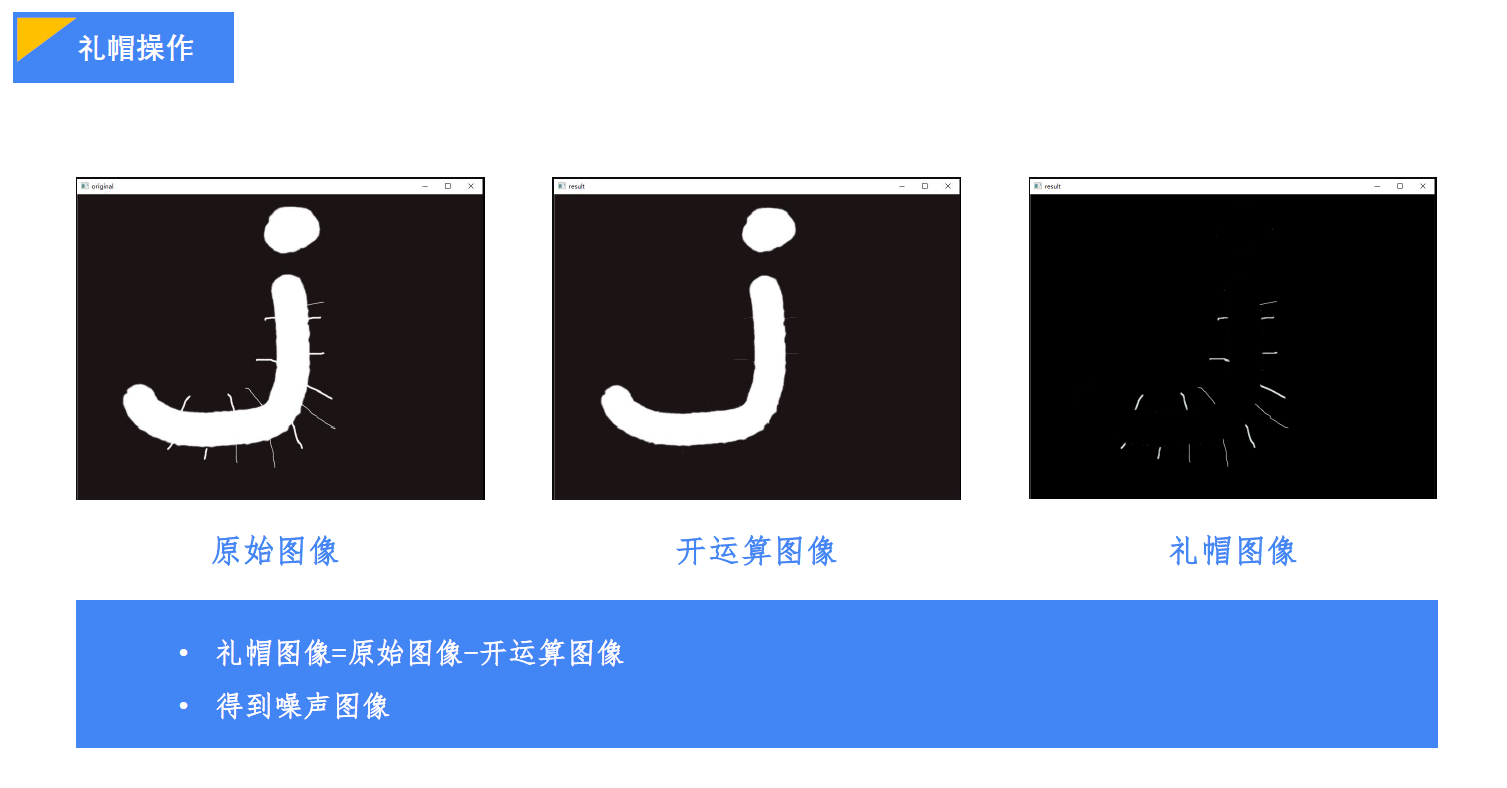
可以使用形态学扩展的API来实现礼帽运算
res = cv2.morphologyEx(img, cv2.MORPH_TOPHAT, kernel)
示例代码:
import cv2
import numpy as np
'''读取图像'''
img = cv2.imread("../001.jpg", cv2.IMREAD_GRAYSCALE)
_, img = cv2.threshold(img, 180, 255, cv2.THRESH_BINARY_INV)
cv2.imshow("origin", img)
'''礼帽运算'''
kernel = np.ones((3, 3), np.uint8)
res = cv2.morphologyEx(img, cv2.MORPH_TOPHAT, kernel)
cv2.imshow("res", res)
'''等待、关闭图像'''
cv2.waitKey(0)
cv2.destroyAllWindows()
效果:
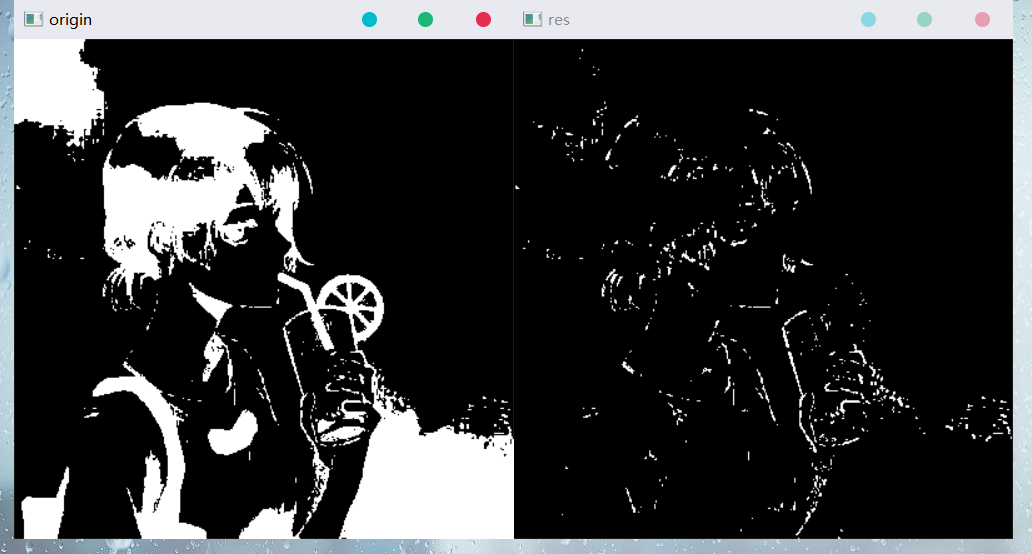
7、黑帽运算
黑帽运算
黑帽运算的操作就相当于用闭运算图像减去原始图像,可以得到图像内部的小孔、小黑点
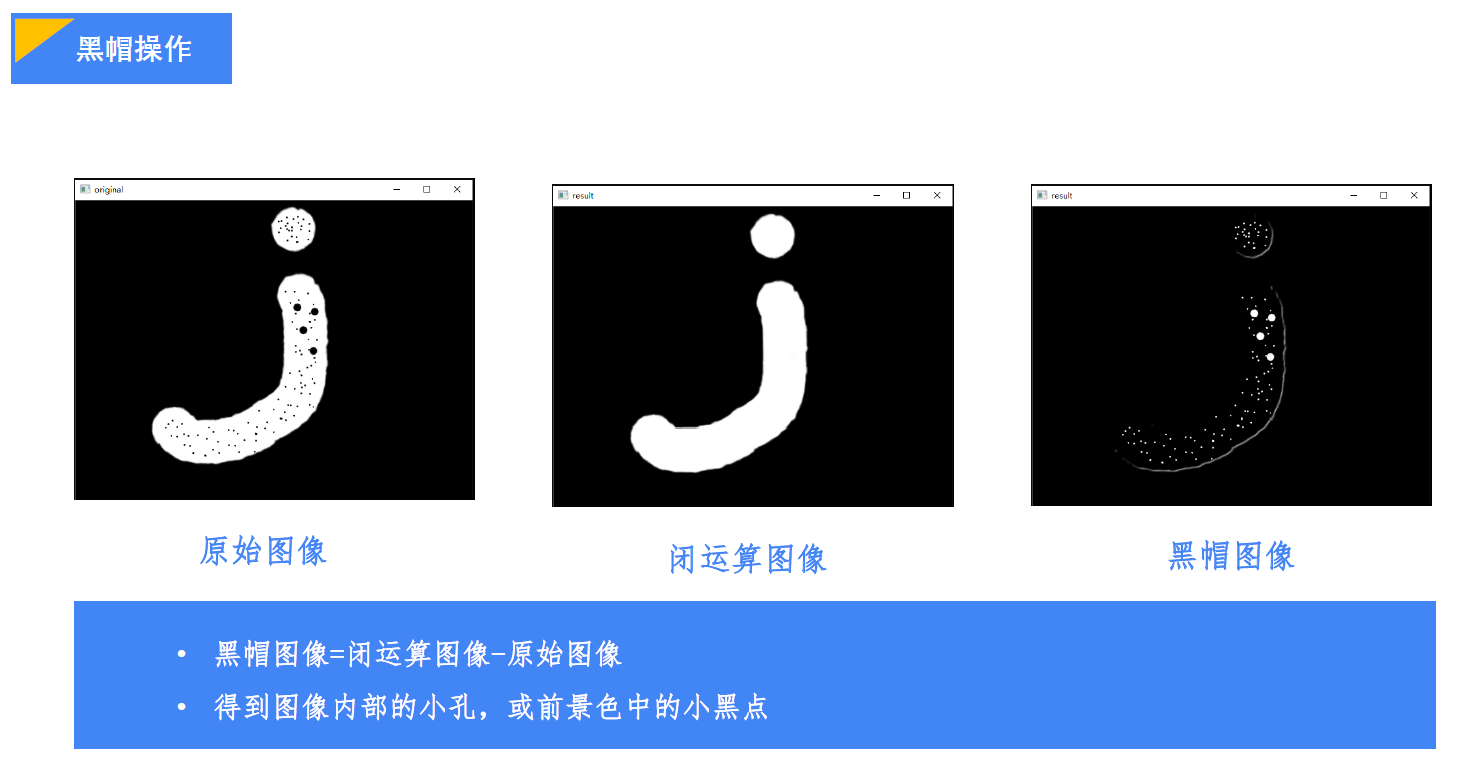
可以使用形态学扩展的API来实现礼帽运算
res = cv2.morphologyEx(img, cv2.MORPH_BLACKHAT, kernel)
示例代码:
import cv2
import numpy as np
'''读取图像'''
img = cv2.imread("../001.jpg", cv2.IMREAD_GRAYSCALE)
_, img = cv2.threshold(img, 180, 255, cv2.THRESH_BINARY_INV)
cv2.imshow("origin", img)
'''礼帽运算'''
kernel = np.ones((3, 3), np.uint8)
res = cv2.morphologyEx(img, cv2.MORPH_BLACKHAT, kernel)
cv2.imshow("res", res)
'''等待、关闭图像'''
cv2.waitKey(0)
cv2.destroyAllWindows()
效果:
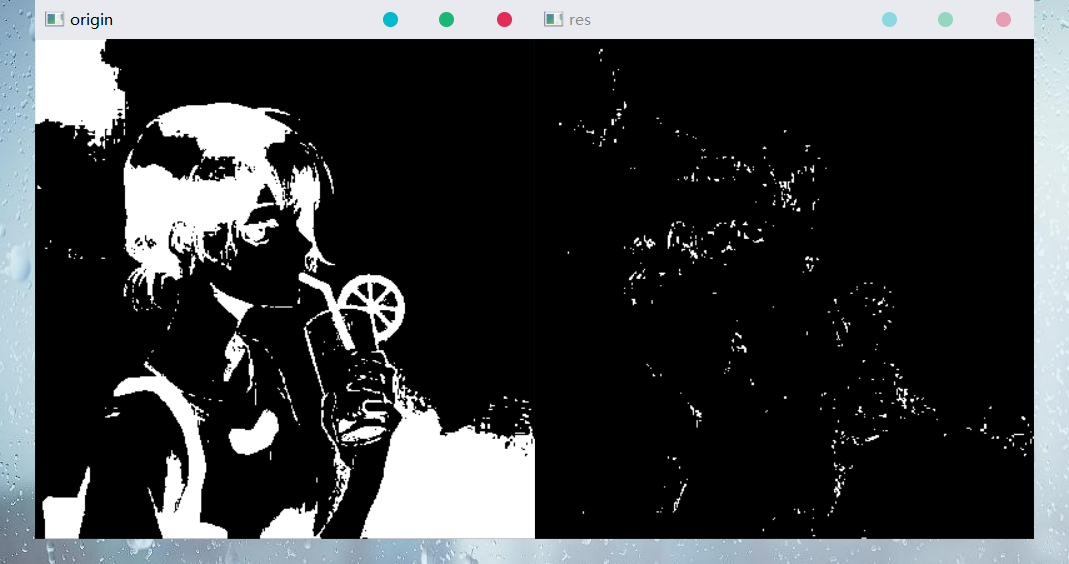
九、图像梯度
1、sobel算子
理论基础
使用一个卷积核 G x = [ − 1 0 1 − 2 0 2 − 1 0 1 ] G_x = \begin{bmatrix} {\color{blue}-1} & 0 & {\color{blue}1} \\ {\color{orange}-2} & 0 & {\color{orange}2} \\ {\color{green}-1} & 0 & {\color{green}1} \\ \end{bmatrix} Gx=⎣⎡−1−2−1000121⎦⎤,使其与图像部分 [ P 1 P 2 P 3 P 4 P 5 P 6 P 7 P 8 P 9 ] \begin{bmatrix} {\color{blue}P_1} & P_2 & {\color{blue}P_3} \\ {\color{orange}P_4} & {\color{red}P_5} & {\color{orange}P_6} \\ {\color{green}P_7} & P_8 & {\color{green}P_9} \\ \end{bmatrix} ⎣⎡P1P4P7P2P5P8P3P6P9⎦⎤转置后进行乘法,即可得到图像部分的中心点 P 5 P_5 P5处的 x x x方向的梯度 P 5 x {P_5}_x P5x(这里的 G x G_x Gx在靠近中心 P 5 P_5 P5的 P 4 P_4 P4和 P 6 P_6 P6选择了更大的权重 2 2 2)
这样的计算可以用于 x x x方向上的边界检测:
- 如果 P 5 x {P_5}_x P5x很大,说明在 P 5 P_5 P5点右边的像素值和左边的像素值差别很大,就说明 P 5 P_5 P5是 x x x方向上的一个边界点
- 如果 P 5 x {P_5}_x P5x很小,说明在 P 5 P_5 P5点右边的像素值和左边的像素值差别不大,就说明 P 5 P_5 P5不是 x x x方向上的一个边界点
类似的,也还有 y y y方向上的梯度,可以用一个卷积核 G y G_y Gy来进行计算
那么就可以根据 G x G_x Gx和 G y G_y Gy来计算一个图像的梯度,即 G = G x 2 + G y 2 G = \sqrt{{G_x}^2 + {G_y}^2} G=Gx2+Gy2
此外,也可以简化为 G = ∣ G x ∣ + ∣ G y ∣ G = | G_x | + | G_y | G=∣Gx∣+∣Gy∣
这就是我们所谓的sobel算子
同样,对于某个具体的点的sobel算子也有 P 5 sobel = ∣ P 5 x ∣ + ∣ P 5 y ∣ {P_5}_{\text{sobel}} = | {P_5}_x | + | {P_5}_y | P5sobel=∣P5x∣+∣P5y∣
Tips:关于【为什么要加上绝对值、如何对图像深度进行设置、如何取绝对值】
-
如果直接计算,可能会出现负值,比如-255,那就很有可能被截断为0,而无法识别出其为边界点,因此,需要加上绝对值
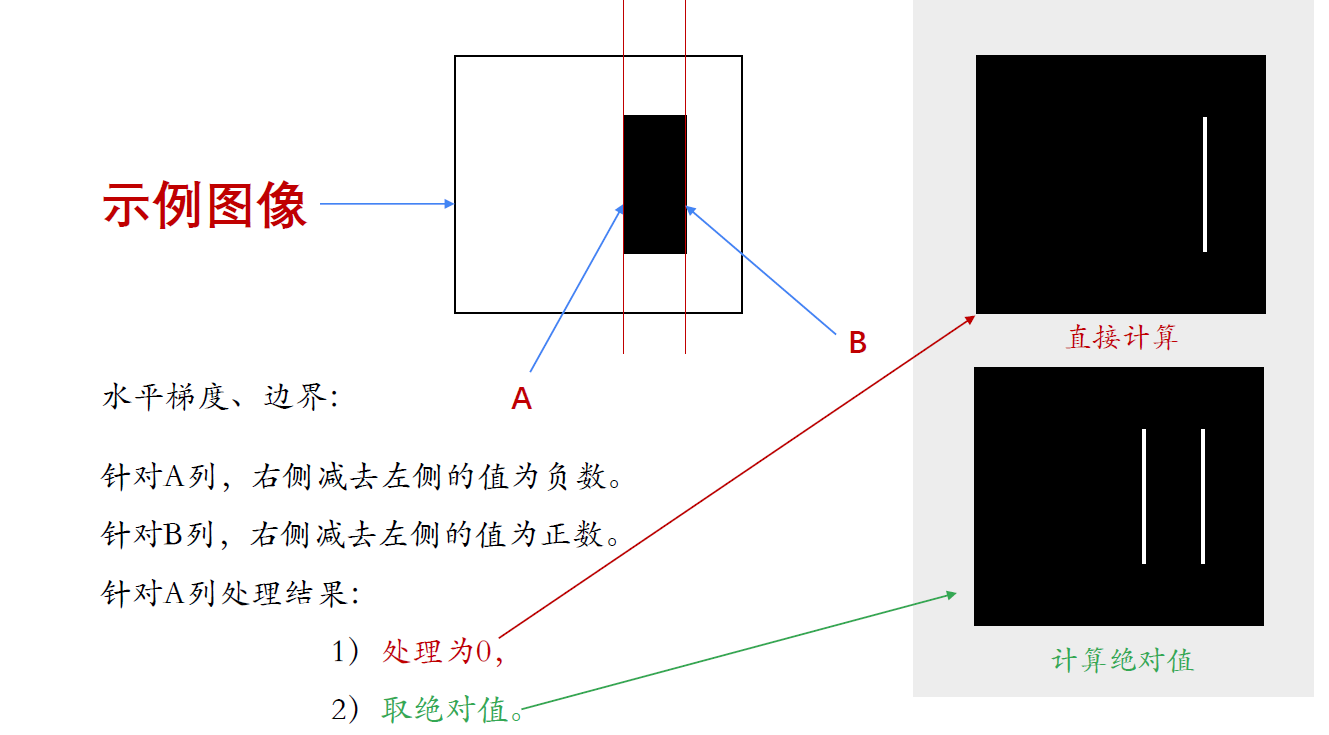
-
实际操作中,计算梯度值可能出现负数,通常处理的图像是
np.uint8类型(cv2.CV_8U),如果结果也是该类型,所有负数会自动截断为0,从而发生信息丢失,所以,在计算时,深度参数ddepth可以使用更高的数据类型cv2.CV_64F来保留负数的值,取绝对值后,再转换为np.uint8类型(cv2.CV_8U) -
将原始图像转换为256色位图(负值取绝对值)
res = cv2.convertSacleAbs(img[, alpha[, beta]]) '''一般只用把图像传入即可''' res = cv2.convertSacleAbs(img)
sobel算子
'''
ddepth 处理结果图像深度
通常情况下,可以将该参数的值设置为-1,让处理结果与原始图像保持一致
dx,dy 表示要计算x轴方向、y轴方向的梯度
要计算x轴方向梯度——dx=1, dy=0
要计算x轴方向梯度——dx=0, dy=1
ksize 卷积核大小(一般不用,要用可以设置为奇数)
'''
res = cv2.Sobel(img, ddepth, dx, dy, [ksize])
'''处理方式1(不能很好地处理边界)'''
res = cv2.Sobel(img, ddepth, 1, 1)
'''处理方式2(采用加权和的方式计算,可以很好地处理函数的边界问题)'''
dx = cv2.Sobel(img, ddepth, 1, 0)
dy = cv2.Sobel(img, ddepth, 0, 1)
# res = dx * 系数1 + dy * 系数2
res = cv2.addWeighted(dx, alpha, dy, beta, gamma)
示例代码:
import cv2
import numpy as np
'''读取图像'''
img = cv2.imread("../001.jpg", cv2.IMREAD_GRAYSCALE)
cv2.imshow("origin", img)
'''sobel算子'''
dx = cv2.Sobel(img, cv2.CV_64F, 1, 0)
dy = cv2.Sobel(img, cv2.CV_64F, 0, 1)
dx = cv2.convertScaleAbs(dx)
dy = cv2.convertScaleAbs(dy)
res1 = cv2.addWeighted(dx, 0.5, dy, 0.5, 0)
cv2.imshow("addWeighted", res1)
sobel = cv2.Sobel(img, cv2.CV_64F, 1, 1)
res2 = cv2.convertScaleAbs(sobel)
cv2.imshow("dx=dy=1", res2)
'''等待、关闭图像'''
cv2.waitKey(0)
cv2.destroyAllWindows()
效果:
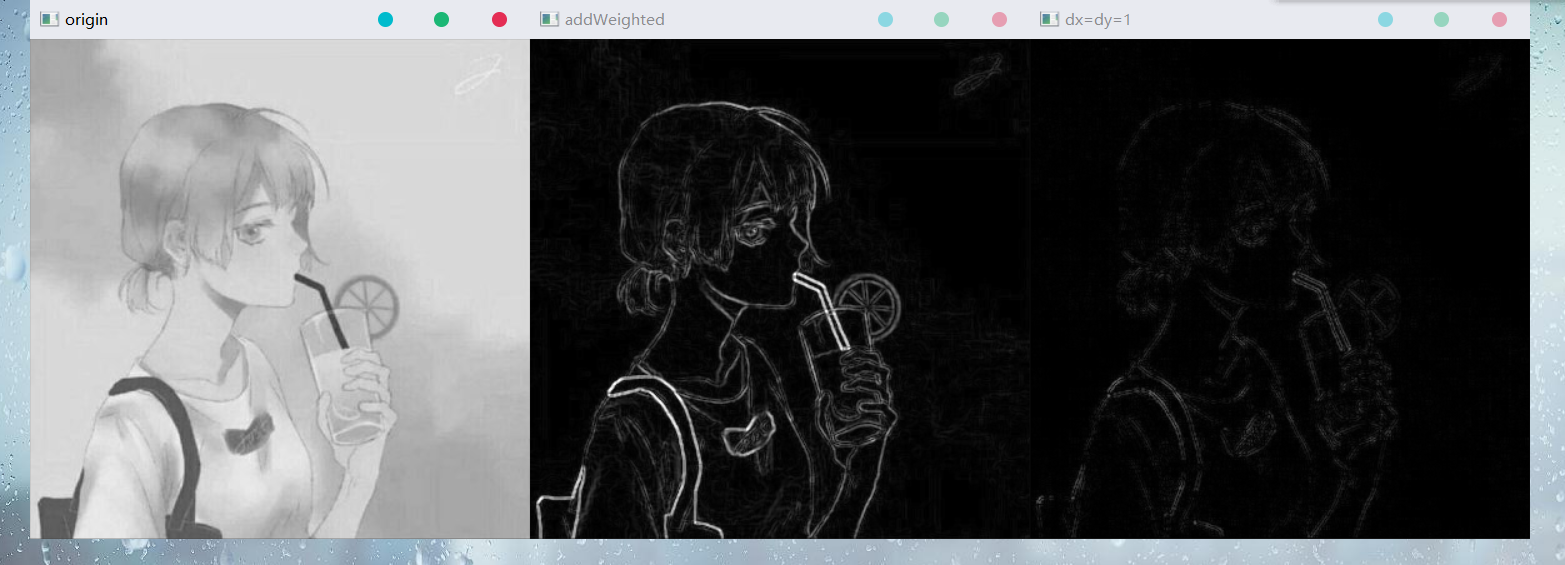
2、scharr算子
理论基础
在使用 3 × 3 3 \times 3 3×3的sobel算子时,可能不太精确,可以使用如下的scharr算子,效果更好:
G x = [ − 3 0 3 − 10 0 10 − 3 0 3 ] G y = [ − 3 − 10 − 3 0 0 0 3 10 3 ] \begin{aligned} & G_x= \begin{bmatrix} -3 & 0 & 3 \\ -10 & 0 & 10 \\ -3 & 0 & 3 \\ \end{bmatrix} \\ \\ & G_y= \begin{bmatrix} -3 & -10 & -3 \\ 0 & 0 & 0 \\ 3 & 10 & 3 \\ \end{bmatrix} \\ \end{aligned} Gx=⎣⎡−3−10−30003103⎦⎤Gy=⎣⎡−303−10010−303⎦⎤
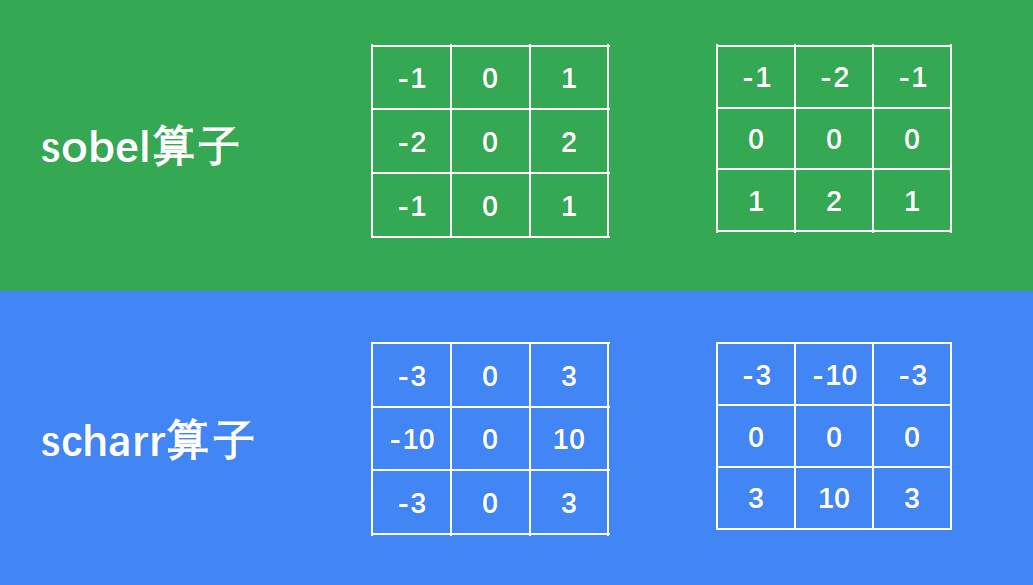
scharr算子
'''
dx,dy dx表示x轴方向,dy表示y轴方向
需要满足 dx>=0, dy>=0, dx+dy==1
scharr其实是改进的sobel算子
res = cv2.Scharr(img, ddepth, dx, dy)
实际上就等价于
res = cv2.Sobel(img, ddepth, dx, dy, -1)
'''
res = cv2.Scharr(img, ddepth, dx, dy)
示例代码:
import cv2
import numpy as np
'''读取图像'''
img = cv2.imread("../001.jpg", cv2.IMREAD_GRAYSCALE)
cv2.imshow("origin", img)
'''scharr算子'''
dx = cv2.Scharr(img, cv2.CV_64F, 1, 0)
dy = cv2.Scharr(img, cv2.CV_64F, 0, 1)
dx = cv2.convertScaleAbs(dx)
dy = cv2.convertScaleAbs(dy)
res1 = cv2.addWeighted(dx, 0.5, dy, 0.5, 0)
cv2.imshow("addWeighted", res1)
'''等待、关闭图像'''
cv2.waitKey(0)
cv2.destroyAllWindows()
效果:
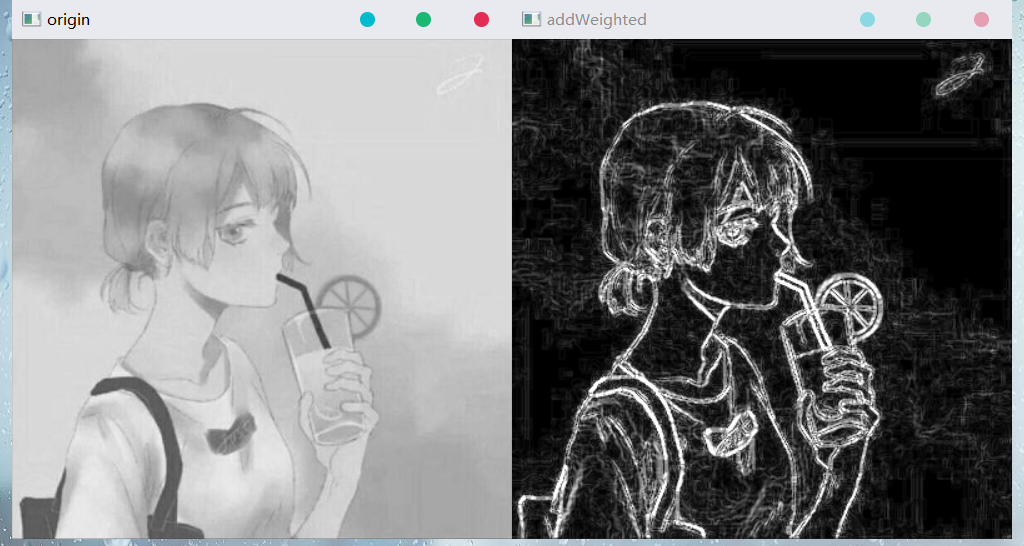
3、laplacian算子(拉普拉斯算子)
理论基础
拉普拉斯算子类似于二阶sobel导数(2次右边减左边、2次下边减上边)
其使用的卷积核为
G = [ 0 1 0 1 − 4 1 0 1 0 ] G=\begin{bmatrix} 0 & 1 & 0 \\ 1 & -4 & 1 \\ 0 & 1 & 0 \\ \end{bmatrix} G=⎣⎡0101−41010⎦⎤
其所计算的某一点的梯度示意如下
[ P 1 P 2 P 3 P 4 P 5 P 6 P 7 P 8 P 9 ] P 5 n e w = ( P 2 + P 4 + P 6 + P 8 ) − 4 ∗ P 5 \begin{aligned} & \begin{bmatrix} P_1 & {\color{blue}P_2} & P_3 \\ {\color{blue}P_4} & {\color{red}P_5} & {\color{blue}P_6} \\ P_7 & {\color{blue}P_8} & P_9 \\ \end{bmatrix} \\ \\ & {P_5}_{new} = (P_2 + P_4 + P_6 + P_8) - 4 * P_5 \\ \end{aligned} ⎣⎡P1P4P7P2P5P8P3P6P9⎦⎤P5new=(P2+P4+P6+P8)−4∗P5
同样,laplacian算子可以用于检测边界

sobel算子、scharr算子、laplacian算子的比较:
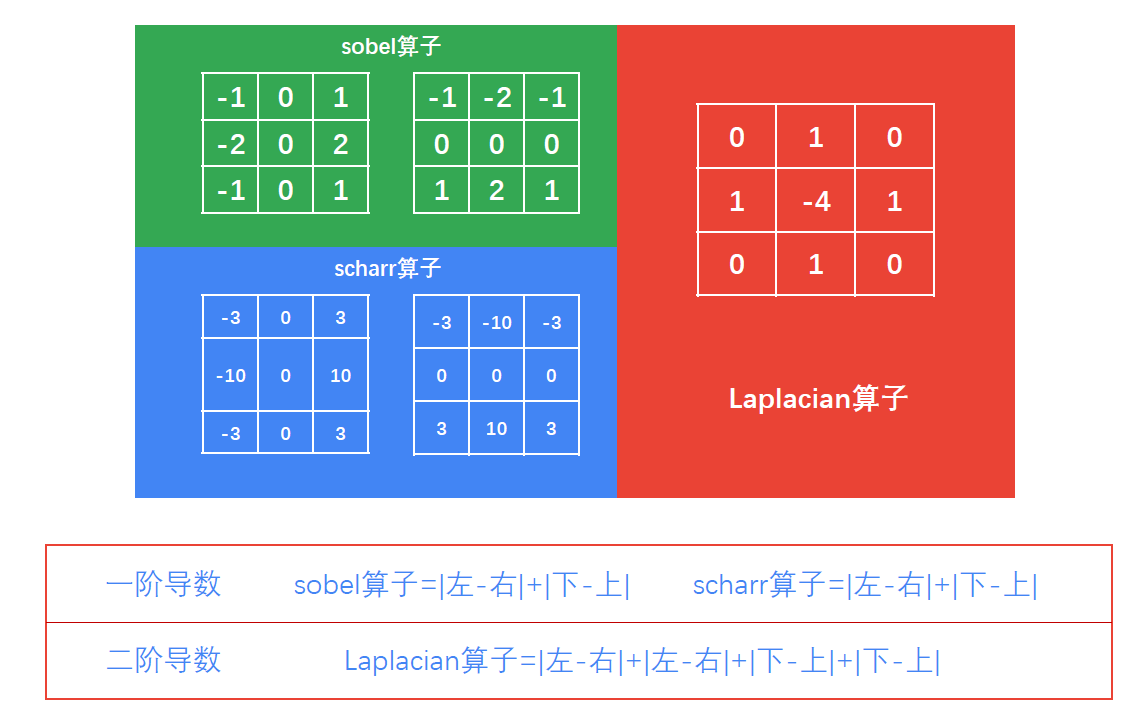
laplacian算子
res = cv2.Laplacian(img, ddepth)
示例代码:
import cv2
import numpy as np
'''读取图像'''
img = cv2.imread("../001.jpg", cv2.IMREAD_GRAYSCALE)
cv2.imshow("origin", img)
'''laplacian算子'''
res = cv2.Laplacian(img, cv2.CV_64F)
res = cv2.convertScaleAbs(res)
cv2.imshow("res", res)
'''等待、关闭图像'''
cv2.waitKey(0)
cv2.destroyAllWindows()
效果:
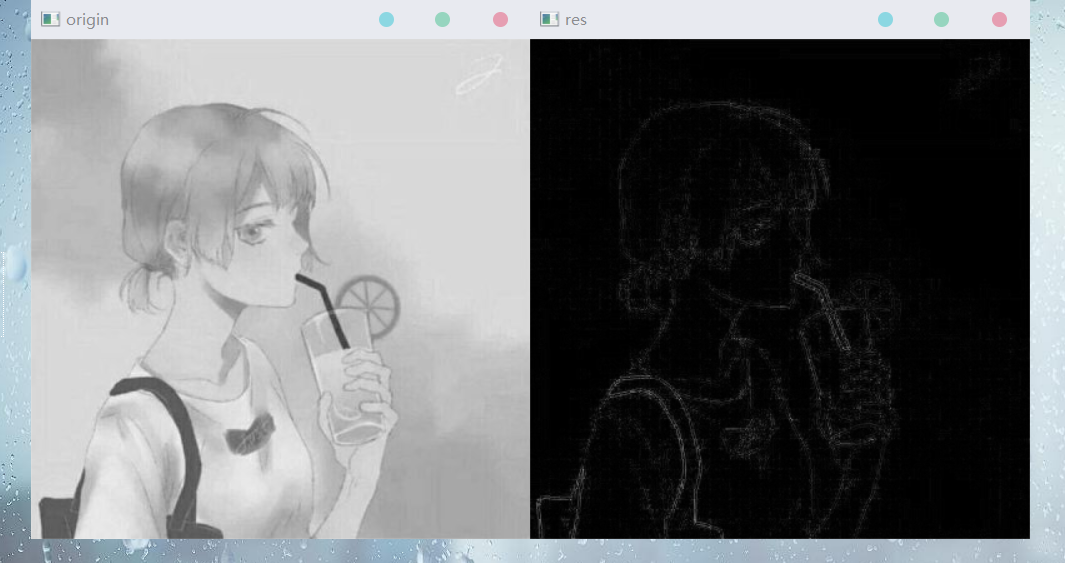
十、Canny边缘检测
Canny边缘检测的一般步骤
-
去噪:
边缘检测容易受到噪声的影响,因此,在边缘检测之前,需要先进行去噪
通常使用高斯滤波进行去噪 -
梯度:

示例:
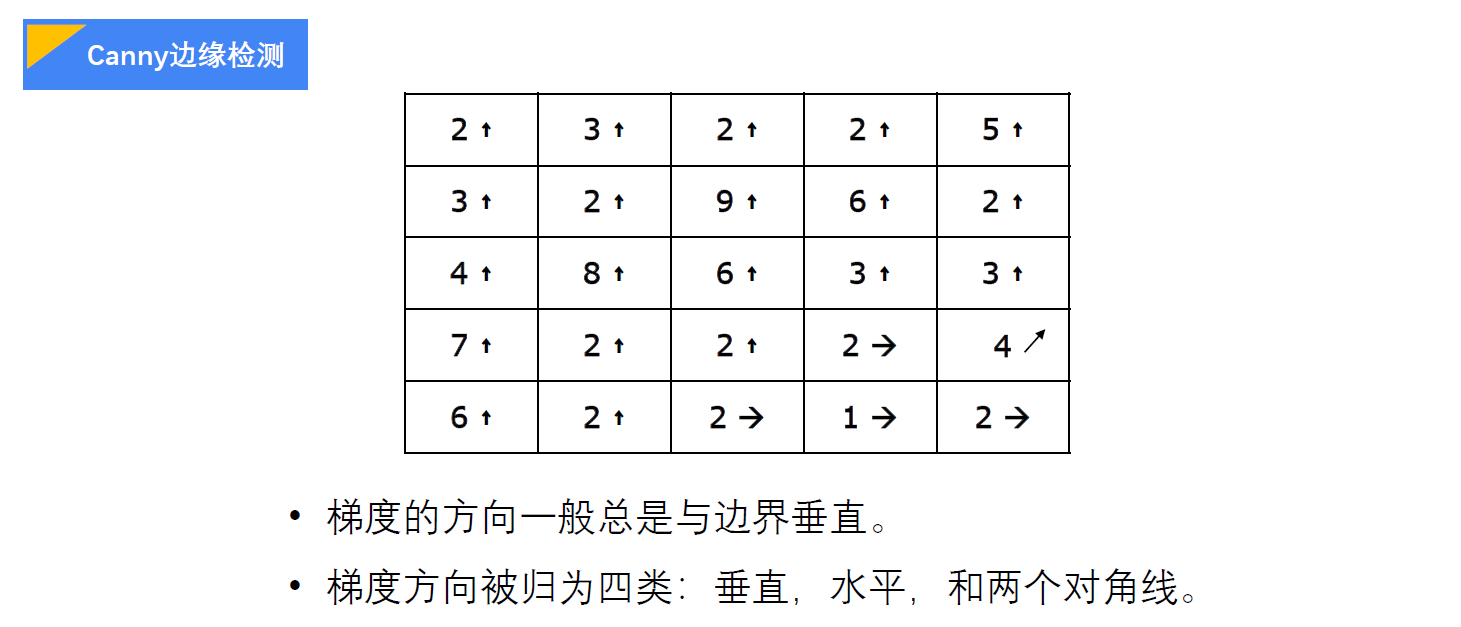
-
非极大值抑制:
在获得了梯度和方向后,遍历图像,去除所有非边界点实现方式:逐个遍历像素点,判断当前像素点是否是周围像素点中具有相同方向梯度的最大值(最大——保留,非最大——抛弃)
示例:
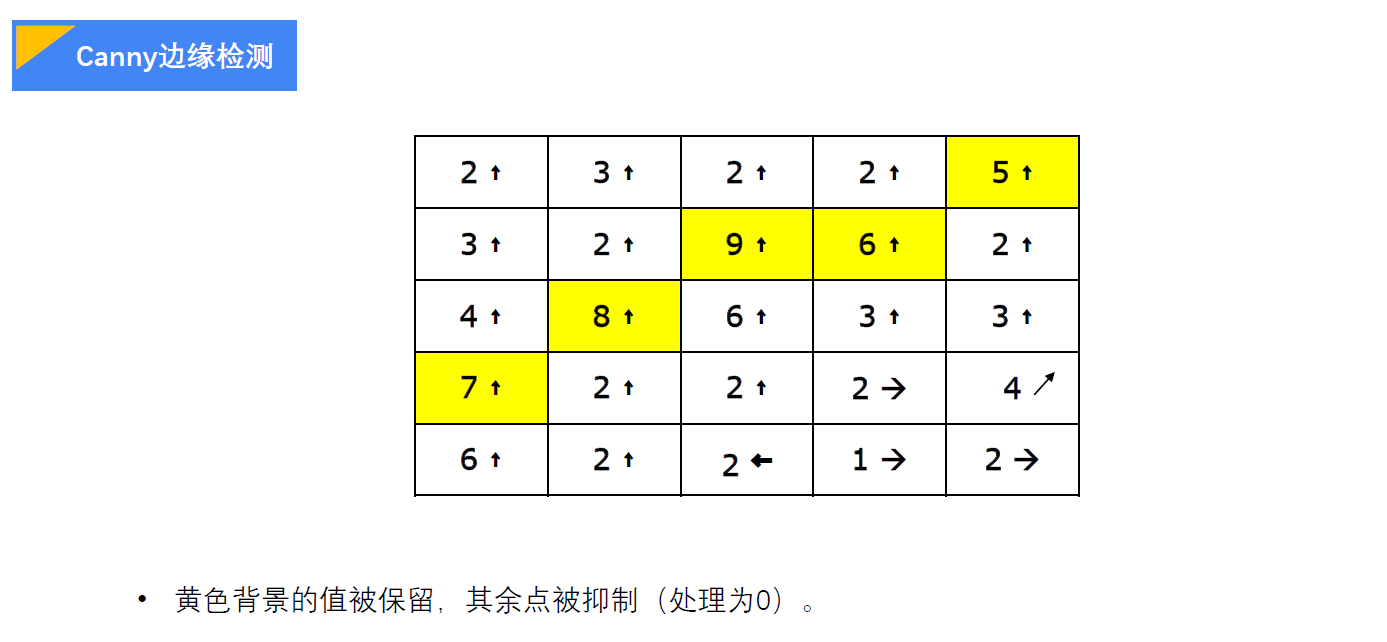
-
滞后阈值:
需要设置两个滞后阈值:minval、maxval
根据剩余的点的梯度值与其相连情况判断,决定是保留/抛弃这个点
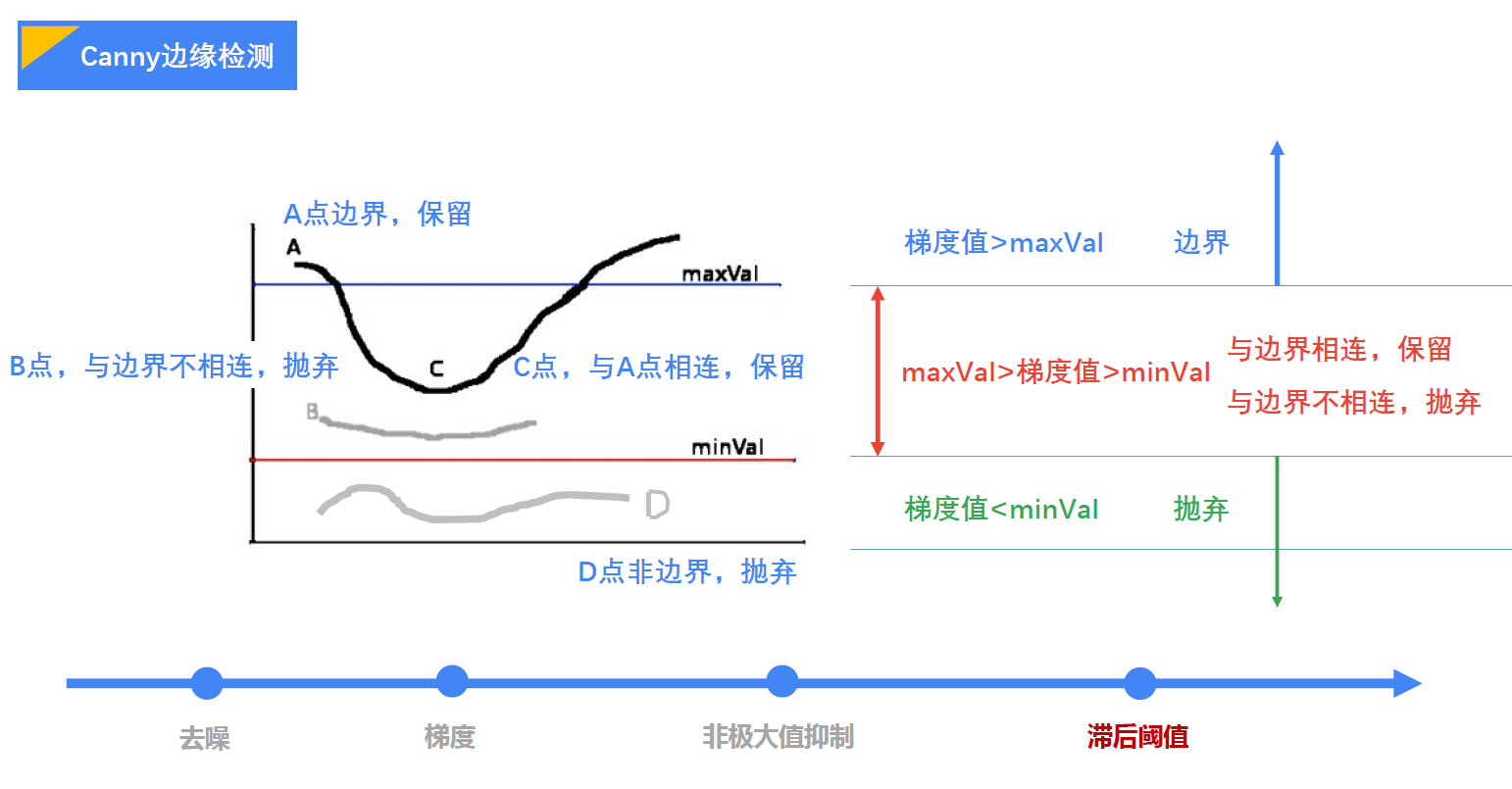
Canny边缘检测
'''
Tips:
如果想让Canny边缘检测的边更多(细节更丰富),可以把这两个值调低
如果想让Canny边缘检测的边少一些(细节不丰富),可以把这两个值调高
'''
res = cv2.Canny(img, threshold1, threshold2)
示例代码:
import cv2
import numpy as np
'''读取图像'''
img = cv2.imread("001.jpg", cv2.IMREAD_GRAYSCALE)
cv2.imshow("origin", img)
'''Canny边缘检测'''
res = cv2.Canny(img, 100, 200)
cv2.imshow("res", res)
'''等待、关闭图像'''
cv2.waitKey(0)
cv2.destroyAllWindows()
效果:
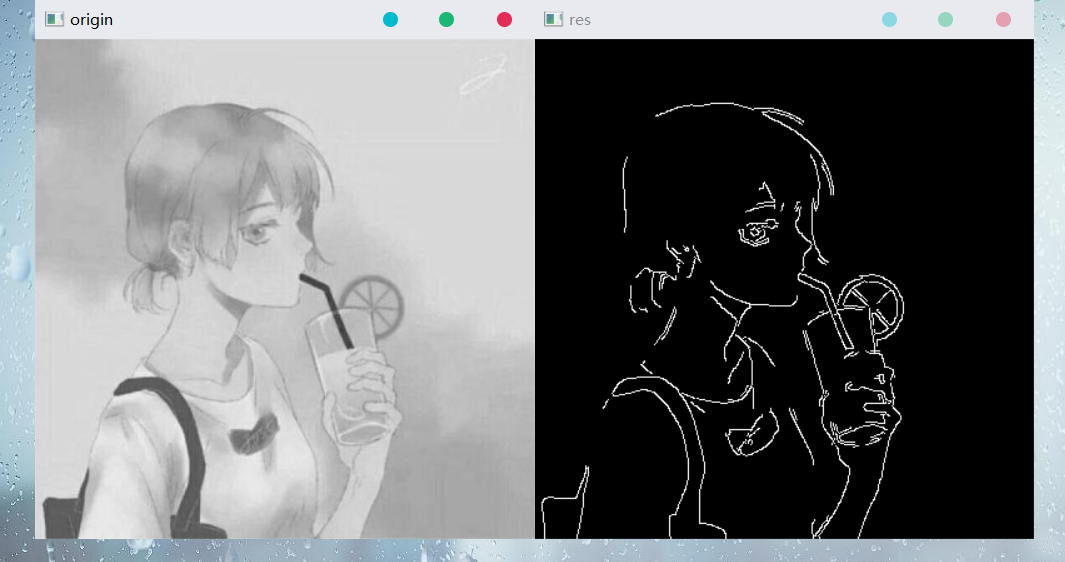
十一、图像金字塔
图像金字塔
-
图像金字塔指的是由同一图像的不同分辨率的子图构成的集合
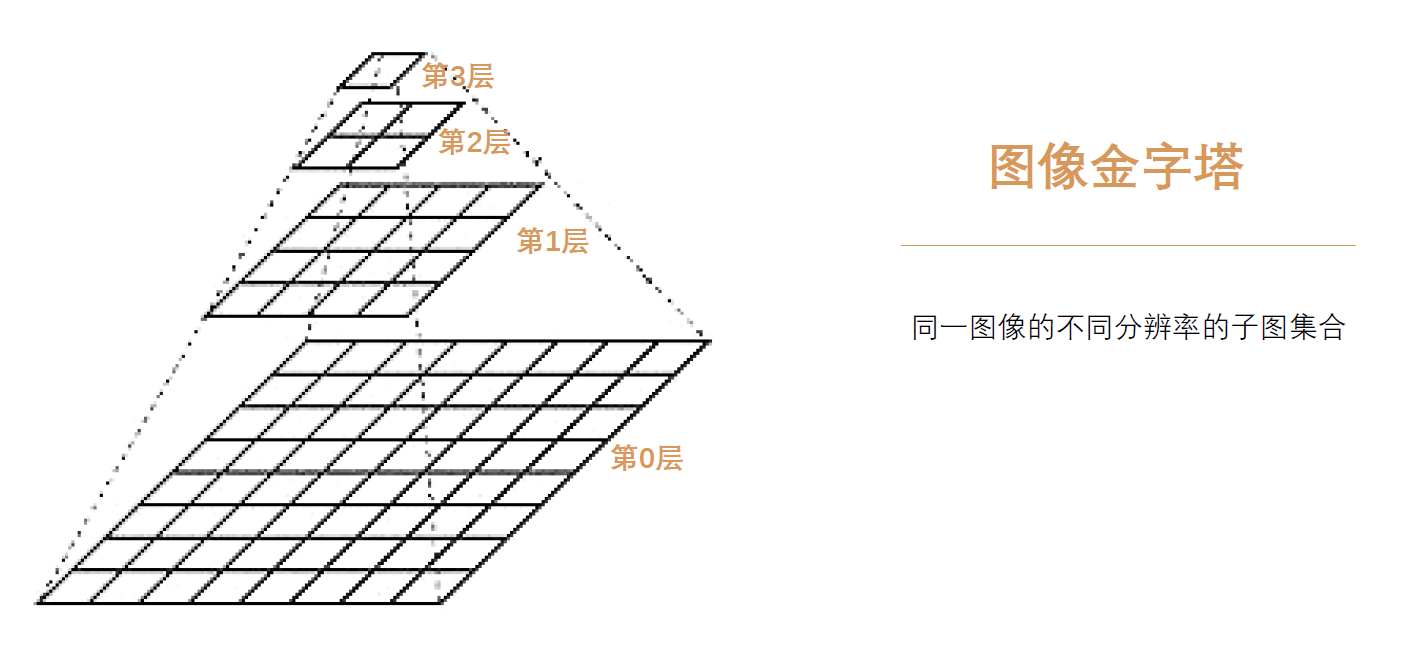
-
生成图像金字塔的方法有两种——下采样(缩小)、上采样(放大)
1、高斯金字塔
下采样
-
下采样即从第 i i i层( G i G_i Gi)获取第 i + 1 i+1 i+1层( G i + 1 G_{i+1} Gi+1)
-
下采样的一般步骤如下:
①、对图像 G i G_i Gi进行高斯核卷积
kernel = 1 256 [ 1 4 6 4 1 4 16 24 16 4 6 24 36 24 6 4 16 24 16 4 1 4 6 4 1 ] \text{kernel} = \frac{1}{256} \begin{bmatrix} 1 & 4 & 6 & 4 & 1 \\ 4 & 16 & 24 & 16 & 4 \\ 6 & 24 & 36 & 24 & 6 \\ 4 & 16 & 24 & 16 & 4 \\ 1 & 4 & 6 & 4 & 1 \\ \end{bmatrix} kernel=2561⎣⎢⎢⎢⎢⎡1464141624164624362464162416414641⎦⎥⎥⎥⎥⎤
显然,距离中心点越近,权重越大②、删除所有偶数行和列
-
每次处理后,原始图像会从 M × N \text{M} \times \text{N} M×N变为 M 2 × N 2 \frac{\text{M}}{2} \times \frac{\text{N}}{2} 2M×2N,即变为原来的 1 4 \frac{1}{4} 41
-
重复进行下采样以构造图像金字塔
-
下采样会丢失信息
上采样
- 上采样即从第 i i i层( G i G_i Gi)获取第 i − 1 i-1 i−1层( G i − 1 G_{i-1} Gi−1)
- 上采样的一般步骤如下:
①、在每个方向上扩大为原来的2倍,新增的行和列以0填充
例 如 : ∣ 45 123 89 149 ∣ ⇒ 扩 充 ∣ 45 0 123 0 0 0 0 0 89 0 149 0 0 0 0 0 ∣ \color{#FFA5FF}例如: \begin{vmatrix} \color{red}45 & \color{red}123 \\ \color{red}89 & \color{red}149 \\ \end{vmatrix} \xRightarrow[]{扩充} \begin{vmatrix} \color{red}45 & 0 & \color{red}123 & 0 \\ 0 & 0 & 0 & 0 \\ \color{red}89 & 0 & \color{red}149 & 0 \\ 0 & 0 & 0 & 0 \\ \end{vmatrix} 例如:∣∣∣∣4589123149∣∣∣∣扩充∣∣∣∣∣∣∣∣4508900000123014900000∣∣∣∣∣∣∣∣
②、使用与下采样相同的卷积核的4倍,以获取新像素的值(要4倍,显然是因为在填充时填充了0,直接用1倍的卷积核滤波时会让像素整体降低到 1 4 \frac{1}{4} 41) - 上采样后的图像会比原来图像模糊
下采样
res = cv2.pyrDown(img)
示例代码:
import cv2
import numpy as np
'''读取图像'''
img = cv2.imread("../001.jpg", cv2.IMREAD_GRAYSCALE)
cv2.imshow("origin", img)
'''下采样'''
G1 = cv2.pyrDown(img)
G2 = cv2.pyrDown(G1)
G3 = cv2.pyrDown(G2)
cv2.imshow("G1", G1)
cv2.imshow("G2", G2)
cv2.imshow("G3", G3)
'''等待、关闭图像'''
cv2.waitKey(0)
cv2.destroyAllWindows()
效果:
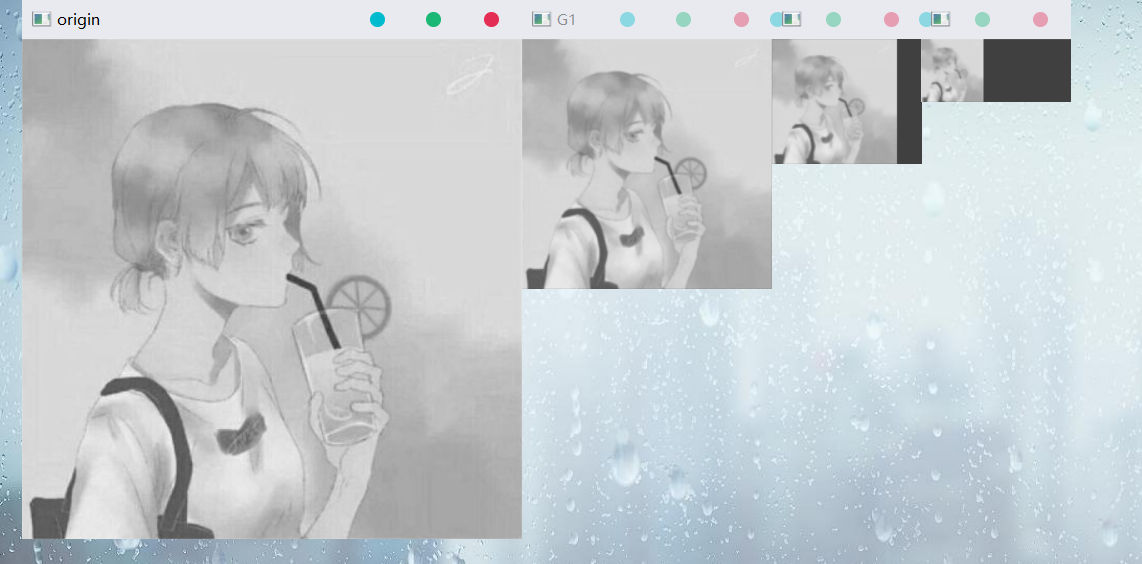
上采样
res = cv2.pyrUp(img)
示例代码:
import cv2
import numpy as np
'''读取图像'''
G3 = cv2.imread("../001.jpg", cv2.IMREAD_GRAYSCALE)
rows, cols = G3.shape[:2]
G3 = cv2.resize(G3, (rows // 2, cols // 2))
cv2.imshow("origin", G3)
'''上采样'''
G2 = cv2.pyrUp(G3)
G1 = cv2.pyrUp(G2)
cv2.imshow("G2", G2)
cv2.imshow("G1", G1)
'''等待、关闭图像'''
cv2.waitKey(0)
cv2.destroyAllWindows()
效果:
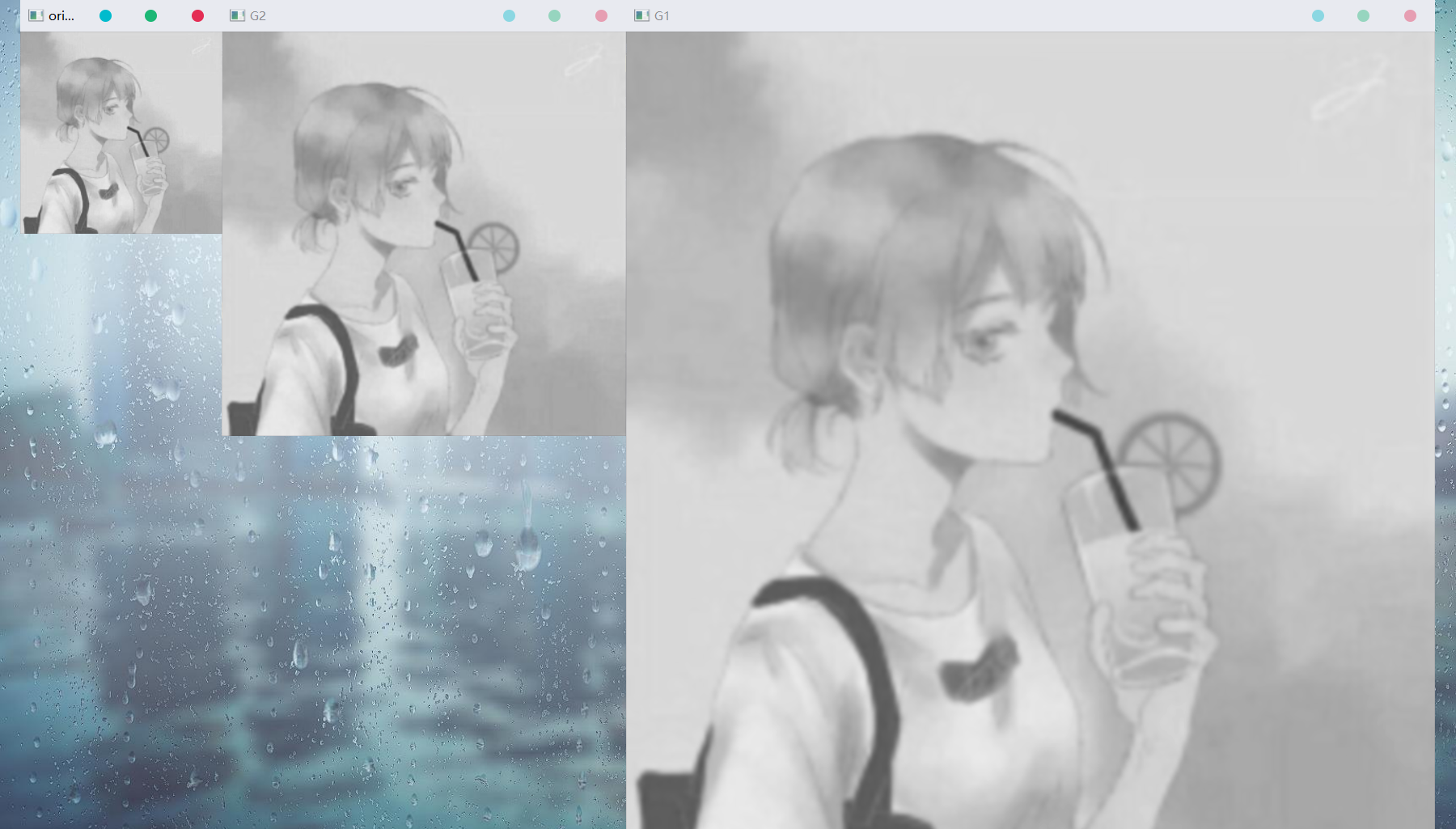
上、下采样的可逆性研究
上、下采样并非互逆操作,不论是先上采样再下采样、还是先下采样再上采样,图像的清晰度都会降低,都无法恢复原有图像
示例代码:
import cv2
import numpy as np
'''读取图像'''
img = cv2.imread("../001.jpg", cv2.IMREAD_GRAYSCALE)
cv2.imshow("origin", img)
'''先下采样,后上采样'''
down1 = cv2.pyrDown(img)
res1 = cv2.pyrUp(down1)
cv2.imshow("res1", res1)
'''先上采样,后下采样'''
up2 = cv2.pyrUp(img)
res2 = cv2.pyrDown(up2)
cv2.imshow("res2", res2)
'''等待、关闭图像'''
cv2.waitKey(0)
cv2.destroyAllWindows()
效果:
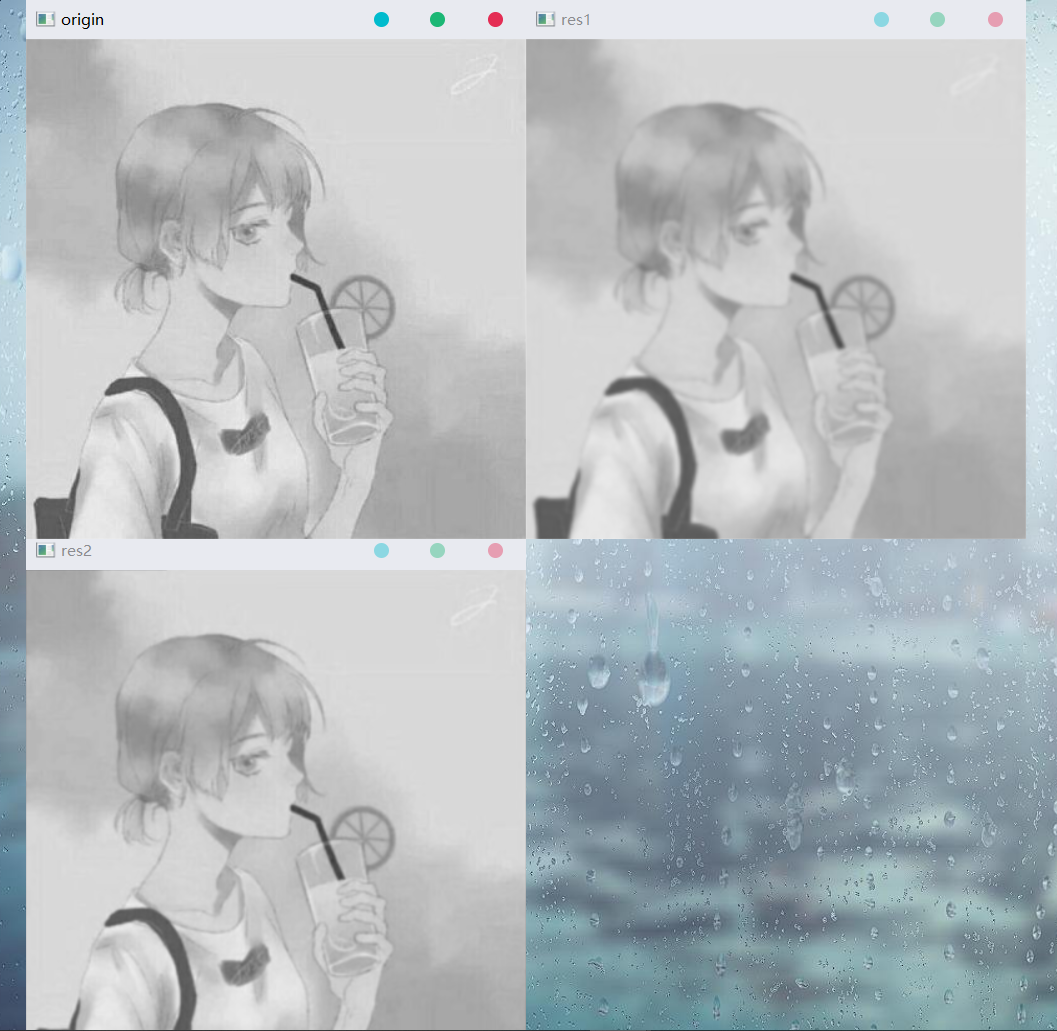
2、拉普拉斯金字塔
拉普拉斯金字塔
拉普拉斯金字塔定义在高斯金字塔的基础之上: L i = G i − Pyrup ( PyrDown ( G i ) ) 其 中 , { G i 原 始 图 像 L i 拉 普 拉 斯 金 字 塔 图 像 \begin{aligned} & L_i = G_i - \text{Pyrup}(\text{PyrDown}(G_i)) \\ \\ & 其中, \begin{cases} G_i & 原始图像 \\ \\ L_i & 拉普拉斯金字塔图像 \\ \end{cases} \end{aligned} Li=Gi−Pyrup(PyrDown(Gi))其中,⎩⎪⎨⎪⎧GiLi原始图像拉普拉斯金字塔图像
拉普拉斯金字塔的结构示意如下:

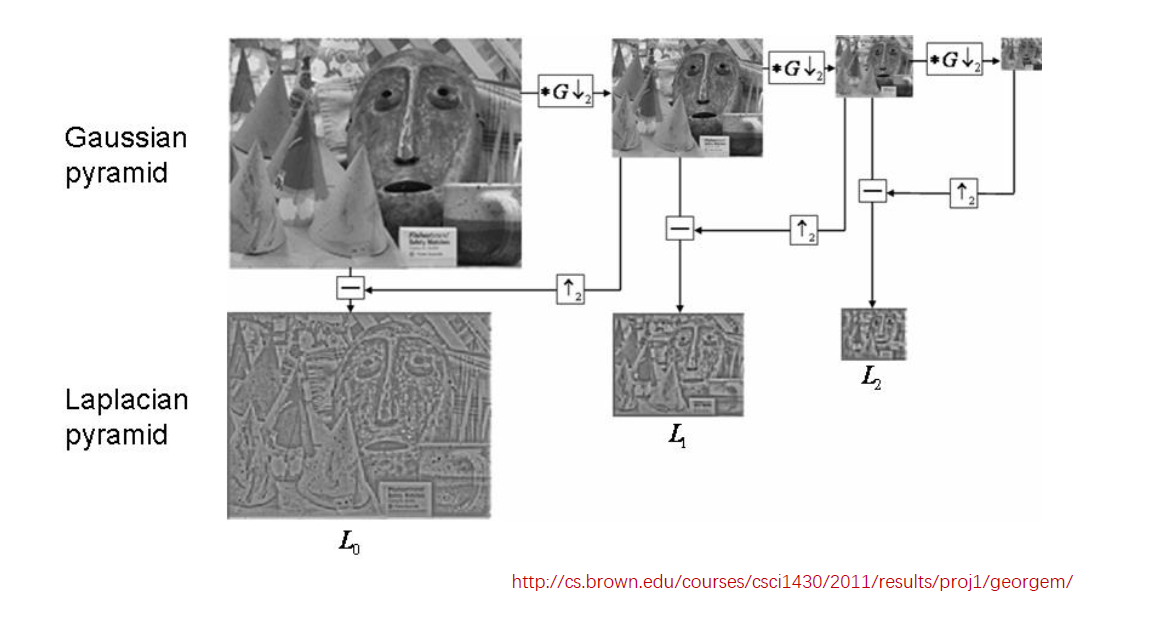
通过拉普拉斯金字塔进行计算,是可以得到原始图像的:
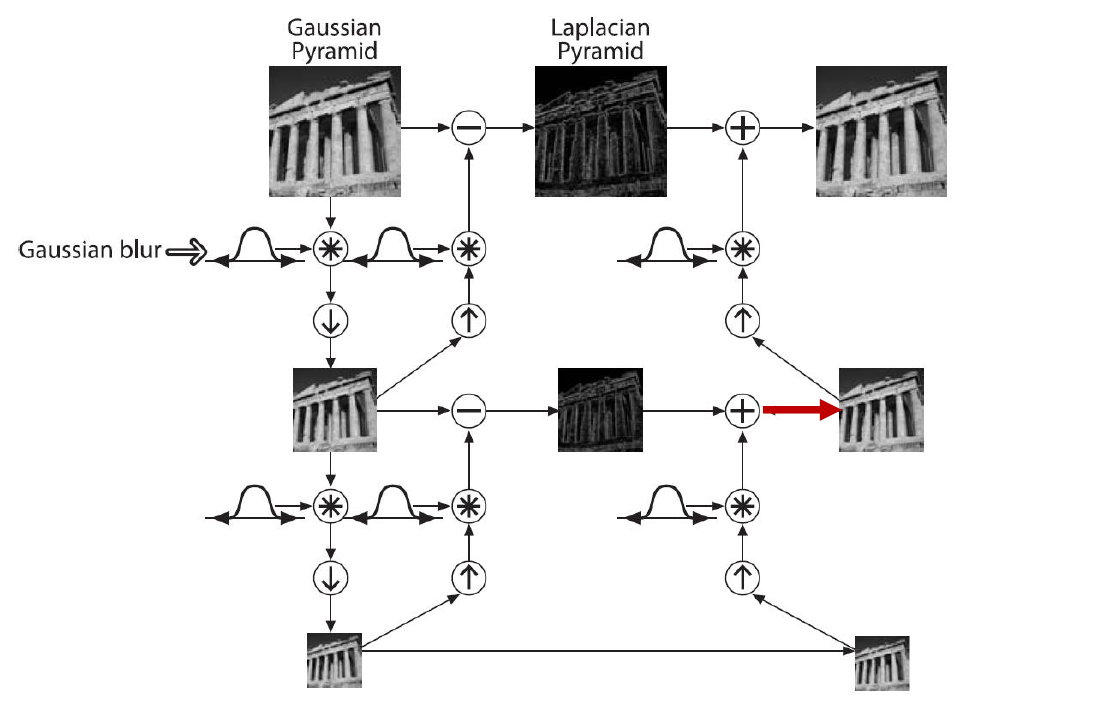
构建拉普拉斯金字塔
o
od = cv2.pyrDown(o)
odu = cv2.pyrUp(od)
l = o - odu
o1 = od
o1d = cv2.pyrDown(o1)
o1du = cv2.pyrUp(o1d)
l1 = o1 - o1du
......
示例代码:
import cv2
import numpy as np
'''读取图像'''
o = cv2.imread("../001.jpg", cv2.IMREAD_GRAYSCALE)
cv2.imshow("origin", o)
'''构建两层拉普拉斯金字塔'''
od = cv2.pyrDown(o)
odu = cv2.pyrUp(od)
l = o - odu
cv2.imshow("odu", odu)
cv2.imshow("l", l)
o1 = od
o1d = cv2.pyrDown(o1)
o1du = cv2.pyrUp(o1d)
l1 = o1 - o1du
cv2.imshow("o1", o1)
cv2.imshow("o1du", o1du)
cv2.imshow("l1", l1)
'''根据拉普拉斯金字塔还原图像'''
_od = cv2.pyrDown(o)
_o1d = cv2.pyrDown(_od)
_o = cv2.pyrUp(_od) + l
_o1 = cv2.pyrUp(_o1d) + l1
cv2.imshow("_o", _o)
cv2.imshow("_o1", _o1)
'''等待、关闭图像'''
cv2.waitKey(0)
cv2.destroyAllWindows()
效果:
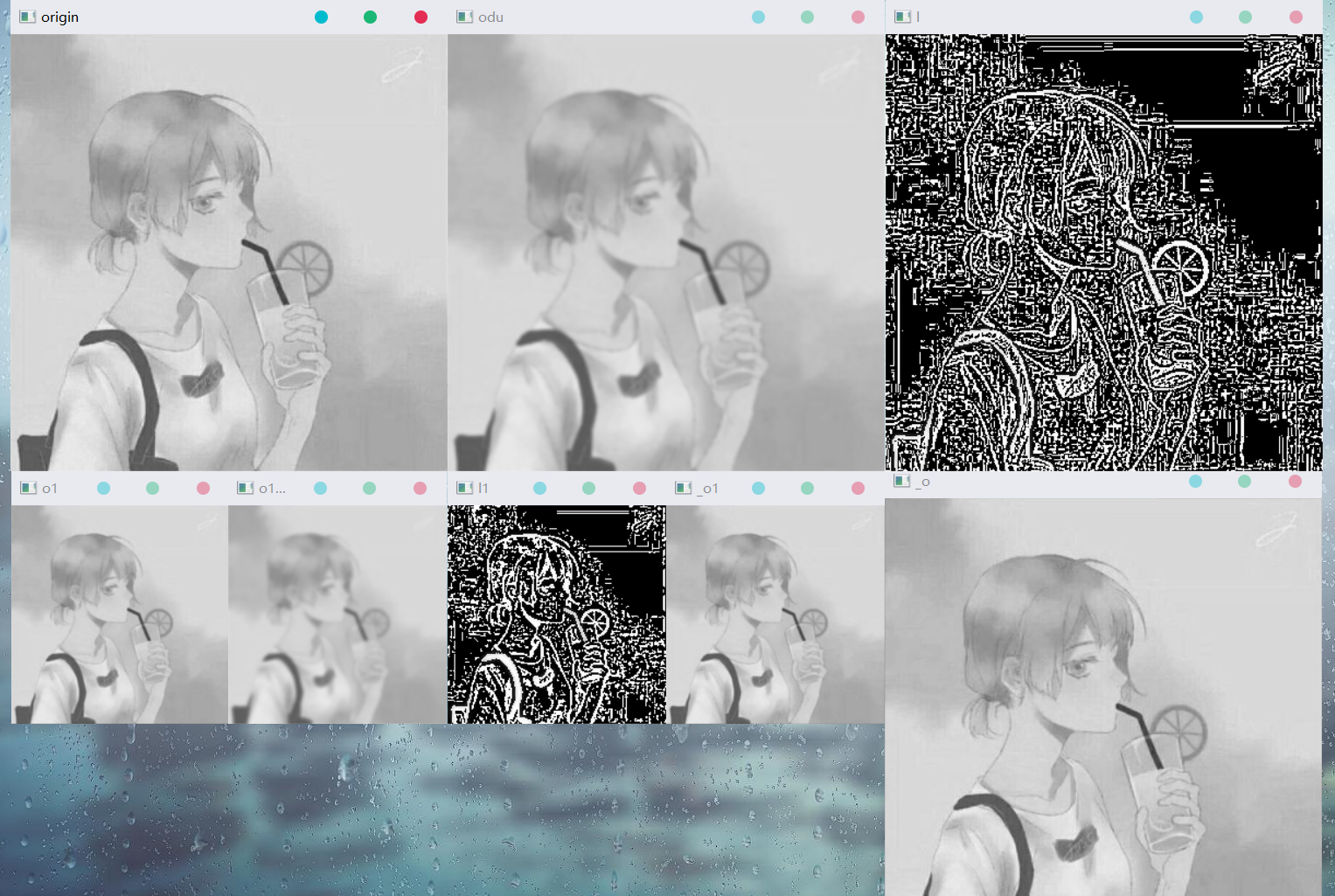
十二、图像轮廓
轮廓
边缘检测能够测出边缘,但边缘是不连续的;将边缘连接为一个整体,构成轮廓。
注意点:
- 计算轮廓的对象需为二值图像,因此需要预先进行阈值分割或者边缘检测处理
- 绘制轮廓(
drawCountours)会更改原始图像,因此在绘制轮廓前,需要对原图像进行拷贝(copy) - 在OpenCV中,黑色为背景色,白色为前景色,因此对象必须为白色,背景必须为黑色
查找轮廓
'''
返回值:
contours 轮廓信息
hierarchy 图像的拓扑信息(轮廓层次)
参数:
img_bin 要操作的二值图像
mode 轮廓的检索模式
- cv2.RETR_EXTERNEL 只检测外轮廓
- cv2.RETR_LIST 检测的轮廓不建立等级关系
- cv2.RETR_CCOMP 建立两个等级的轮廓
上面的一层为外边界
里面的一层为内控的边界信息(若内控内还有一个连通物体,则该物体的边界也在顶层)
★ cv2.RETR_TREE(常用) 建立一个等级树结构的轮廓
method 轮廓的近似方法
- cv2.CHAIN_APPROX_NONE 存储所有的轮廓点,相邻的两个点的像素位置差不超过1
即max(abs(x1-x2), abs(y1-y2)) == 1
- cv2.CHAIN_APPROX_SIMPLE 压缩水平方向、垂直方向、对角线方向的元素,只保留该方向的坐标终点
例如一个矩形轮廓只要用4个点来保存轮廓信息
- cv2.CHAIN_APPROX_TC89_L1 使用teh-Chinl chain近似算法
- cv2.CHAIN_APPROX_TC89_KCOS 使用teh-Chinl chain近似算法
'''
contours, hiearchy = cv2.findCountours(img_bin, mode, method)
绘制轮廓
'''
contours 根据findContours计算得到的边界信息
contourIdx 需要绘制的边界索引(全部绘制则设置为-1)
color 绘制线条的颜色(BGR)
thickness 绘制线条的粗细
'''
res = cv2.drawContours(img_copy, contours, contourIdx, color[, thickness])
'''其实res和img_copy引用了同一张图像,因此我更倾向于写为以下形式'''
res = cv2.drawContours(res, contours, contourIdx, color[, thickness])
示例代码:
import cv2
import numpy as np
'''读取图像'''
img = cv2.imread("001.jpg")
rows, cols = img.shape[:2]
cv2.imshow("origin", img)
'''二值化处理'''
img_gray = cv2.cvtColor(img, cv2.COLOR_BGR2GRAY)
_, img_bin = cv2.threshold(img_gray, 180, 255, cv2.THRESH_BINARY_INV)
cv2.imshow("binary", img_bin)
'''查找轮廓'''
contours, hierarchy = cv2.findContours(img_bin, cv2.RETR_TREE, cv2.CHAIN_APPROX_SIMPLE)
'''绘制轮廓'''
img_copy = img.copy()
res = cv2.drawContours(img_copy, contours, -1, (0, 0, 255), 1)
cv2.imshow("res", res)
cv2.imshow("img_copy", img_copy) # 拷贝图像在drawContours时已经被修改
'''等待、关闭图像'''
cv2.waitKey(0)
cv2.destroyAllWindows()
效果:

十三、直方图
1、直方图
如下图所示,就是一个图像的直方图:

直方图的坐标定义如下:
- 横坐标:图像中各个像素点的灰度级
- 纵坐标:具有该灰度级的像素个数
类似地,还有归一化直方图:
- 横坐标:图像中各个像素点的灰度级
- 纵坐标:出现这个灰度级的概率
直方图的一些参数
- DIMS:使用参数的数量(灰度级、亮度等)
- BINS:参数子集的数目(比如灰度可以分为
1-3、4-6两个级别,BINS=2) - RANGE:统计灰度值的范围(一般为
[0, 255])
2、统计直方图
(1).Python统计直方图
img_1d = img.ravel()
plt.hist(img_1d, 256)
plt.show()
(2).OpenCV统计直方图
'''
imgs:
图像用[]列出
channels:
指定通道,通过[编号]指定
绘图图像:[0]
彩色图像:[0]——B,[1]——G,[2]——R
mask:
统计整幅图像的直方图:设置None
统计某一部分的直方图:设置掩码图像
histSize:
要计算的BINS的数量,一般为[256]
ranges:
像素值的范围,一般为[0, 255]
accumulate
设置True/False表示是/否累积统计直方图
'''
hist = cv2.calcHist(imgs, channels, mask, histSize, ranges[, accumulate])
示例代码:
import cv2
import matplotlib.pyplot as plt
import numpy as np
'''读取、展示图像'''
img = cv2.imread("../001.jpg")
cv2.imshow("origin", img)
'''统计直方图'''
histB = cv2.calcHist([img], [0], None, [256], [0, 255])
histG = cv2.calcHist([img], [1], None, [256], [0, 255])
histR = cv2.calcHist([img], [2], None, [256], [0, 255])
'''绘制直方图'''
plt.plot(histB, color="b")
plt.plot(histG, color="g")
plt.plot(histR, color="r")
plt.show()
'''等待、关闭图像'''
cv2.waitKey(0)
cv2.destroyAllWindows()
效果:
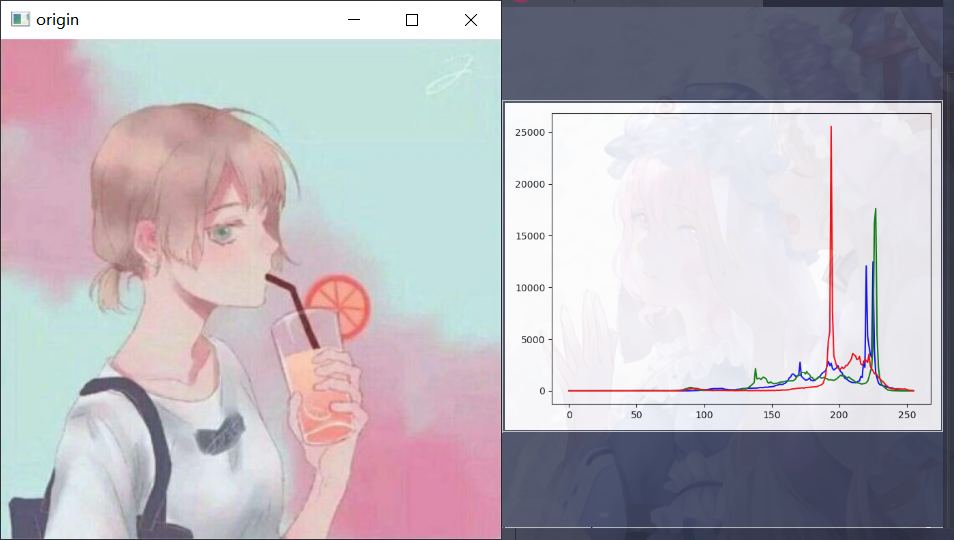
3、掩膜处理
(1).掩膜构建直方图
生成掩膜图像
mask = np.zeros(img.shape, np.uint8)
mask[200:400, 200:400] = 255
示例代码:
import cv2
import matplotlib.pyplot as plt
import numpy as np
'''读取、展示图像'''
img = cv2.imread("../001.jpg", cv2.IMREAD_GRAYSCALE)
cv2.imshow("origin", img)
'''生成掩膜图像'''
mask = np.zeros(img.shape, np.uint8)
mask[200:400, 200:400] = 255
'''统计直方图'''
histG = cv2.calcHist([img], [0], None, [256], [0, 255])
histM = cv2.calcHist([img], [0], mask, [256], [0, 255])
'''绘制直方图'''
plt.plot(histG, color="g")
plt.plot(histM, color="r")
plt.show()
'''等待、关闭图像'''
cv2.waitKey(0)
cv2.destroyAllWindows()
效果:
(2).掩膜处理
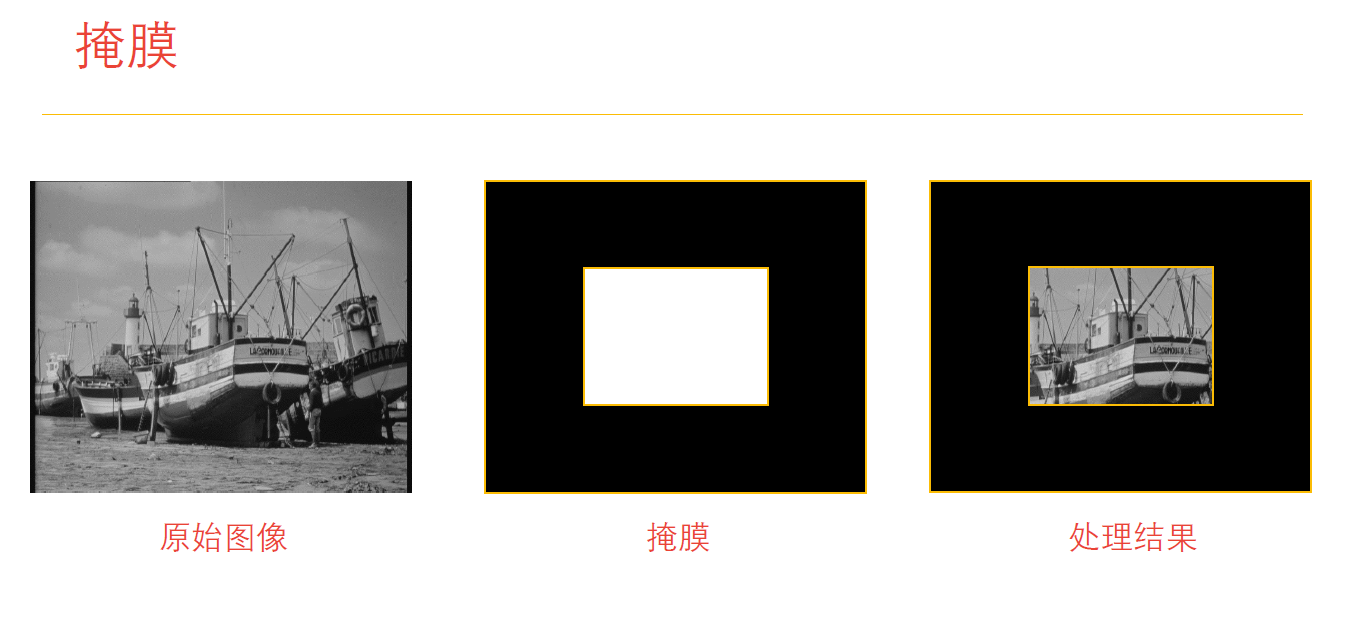
掩膜处理其实就是将原始图像和掩膜图像进行按位与操作
img_masked = cv2.bitwise_and(img, mask)
示例代码:
import cv2
import matplotlib.pyplot as plt
import numpy as np
'''读取、展示图像'''
img = cv2.imread("../001.jpg", cv2.IMREAD_GRAYSCALE)
cv2.imshow("origin", img)
'''生成掩膜图像'''
mask = np.zeros(img.shape, np.uint8)
mask[100:300, 100:300] = 255
'''掩膜处理'''
img_masked = cv2.bitwise_and(img, mask)
cv2.imshow("masked", img_masked)
'''等待、关闭图像'''
cv2.waitKey(0)
cv2.destroyAllWindows()
效果:

4、直方图均衡化
直方图均衡化

通过直方图的均衡化,可以将较亮/较暗的图像处理为比较正常的图像:
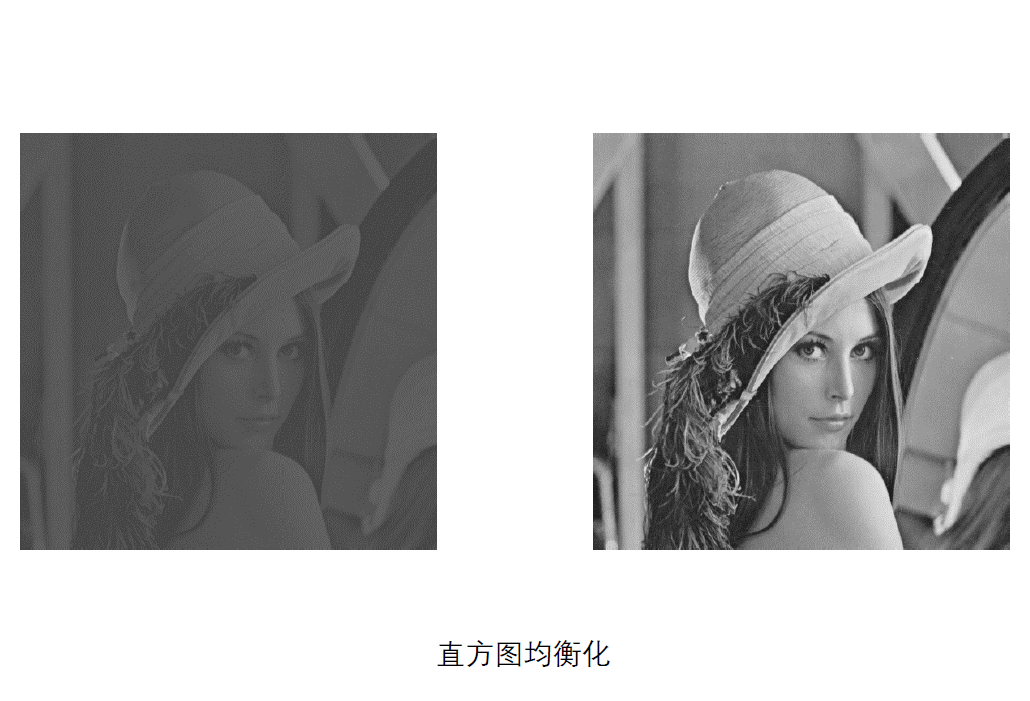
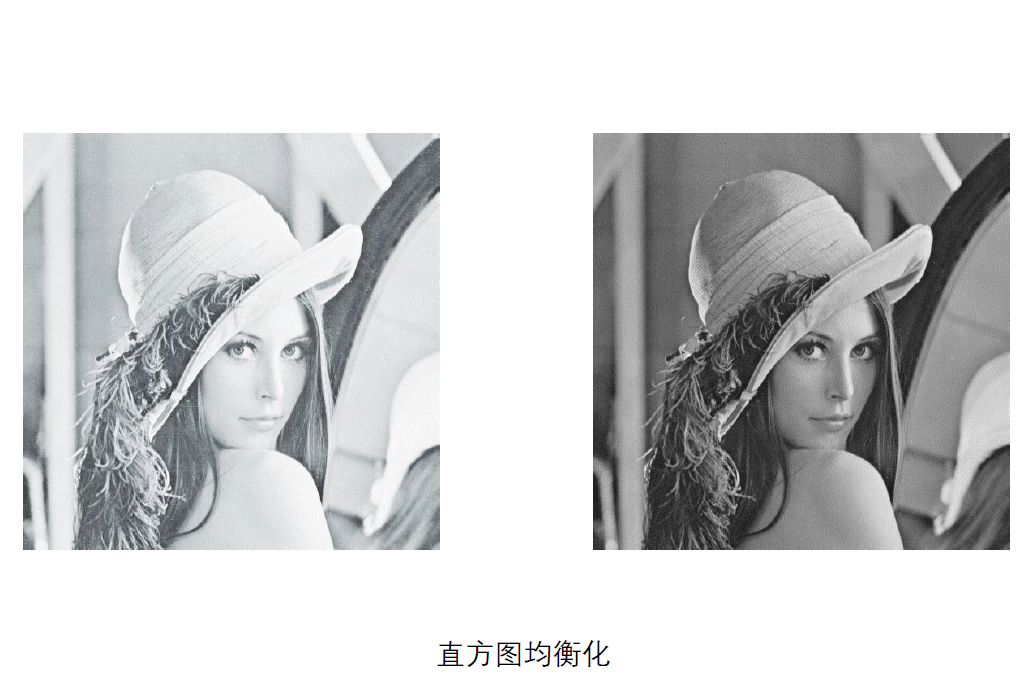
直方图均衡化的图像特征
- 前提:占有全部可能的灰度级并且均匀分布
- 结论:具有高对比度和多变的灰度色调
- 外观:图像细节丰富,质量更高
均衡化步骤
- 计算累计直方图
- 将累计直方图进行区间转换
- 在累积直方图中,概率相近的原始值,会被处理为相同的值(人眼处理)
具体步骤
原始图像→统计直方图→归一化直方图→累计直方图→均衡直方图
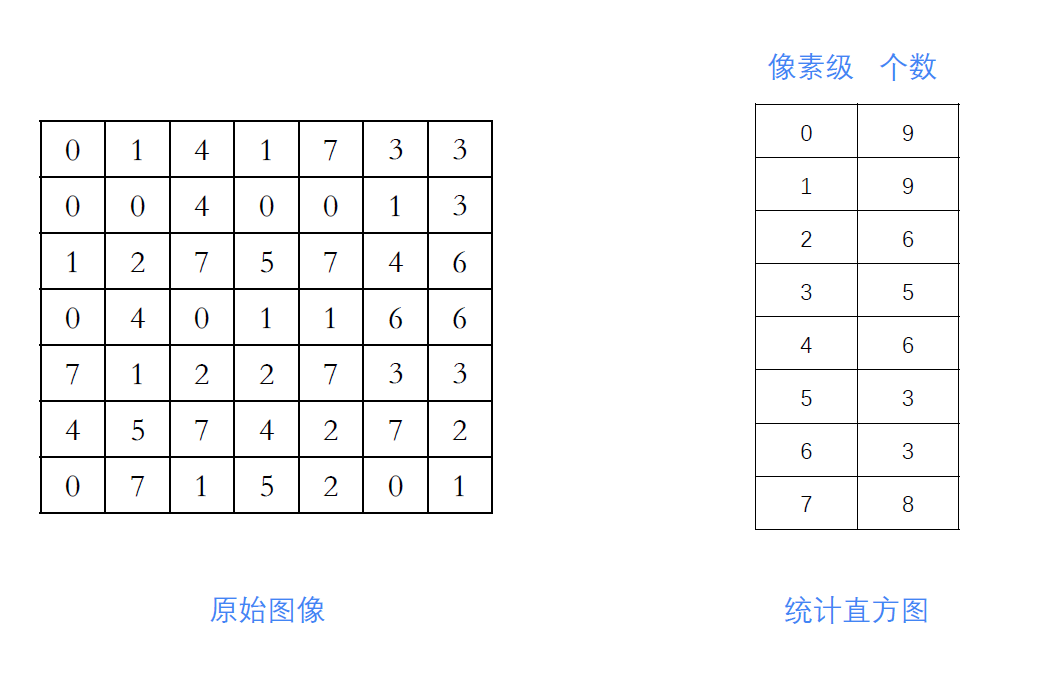
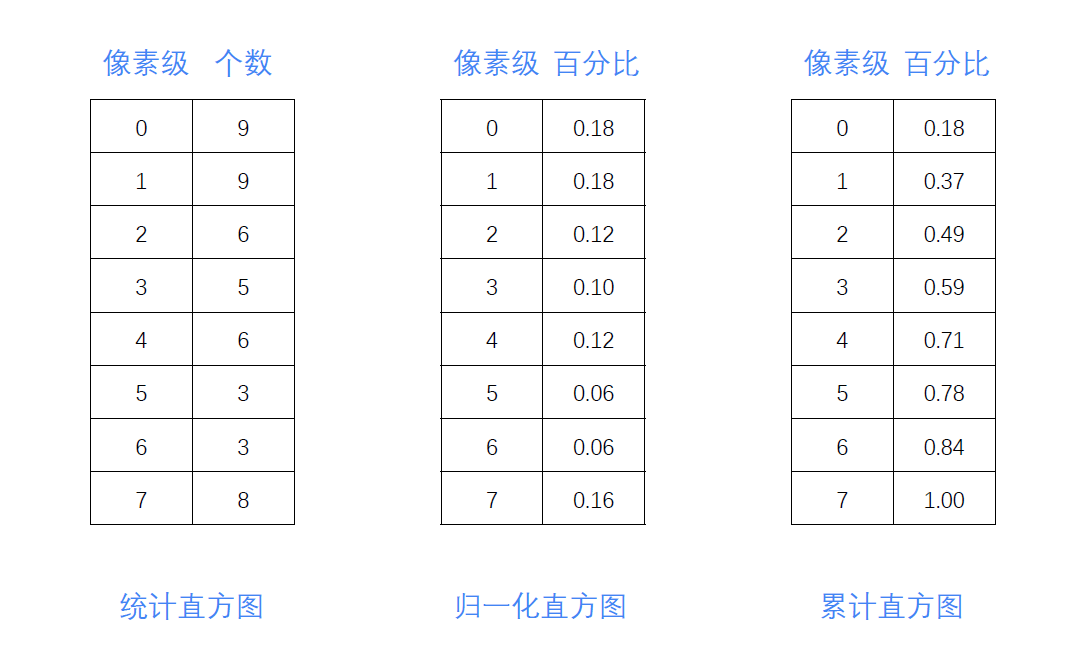
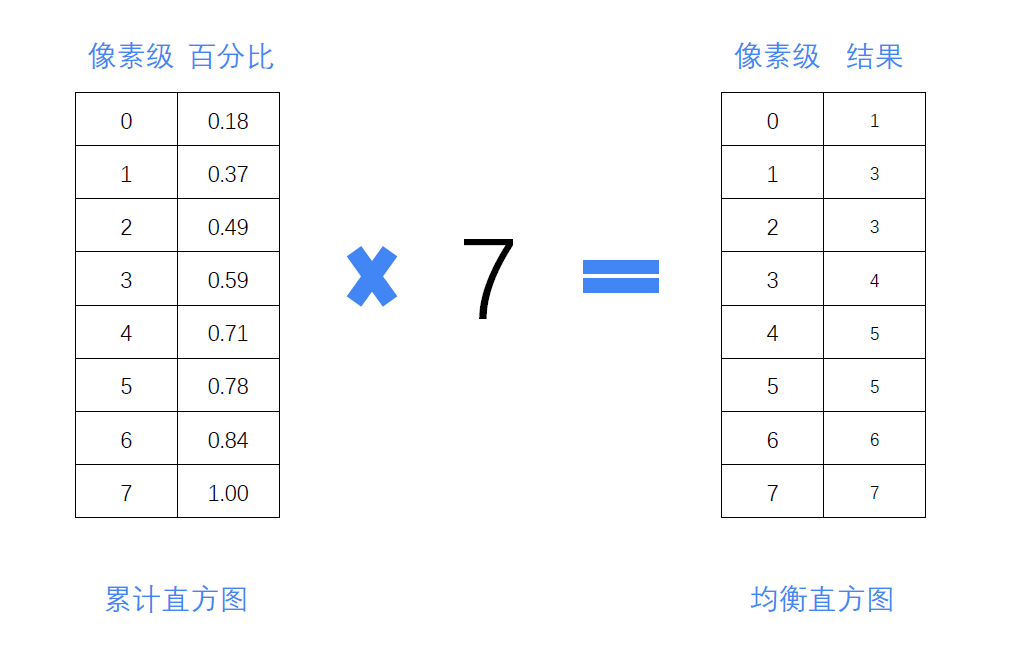

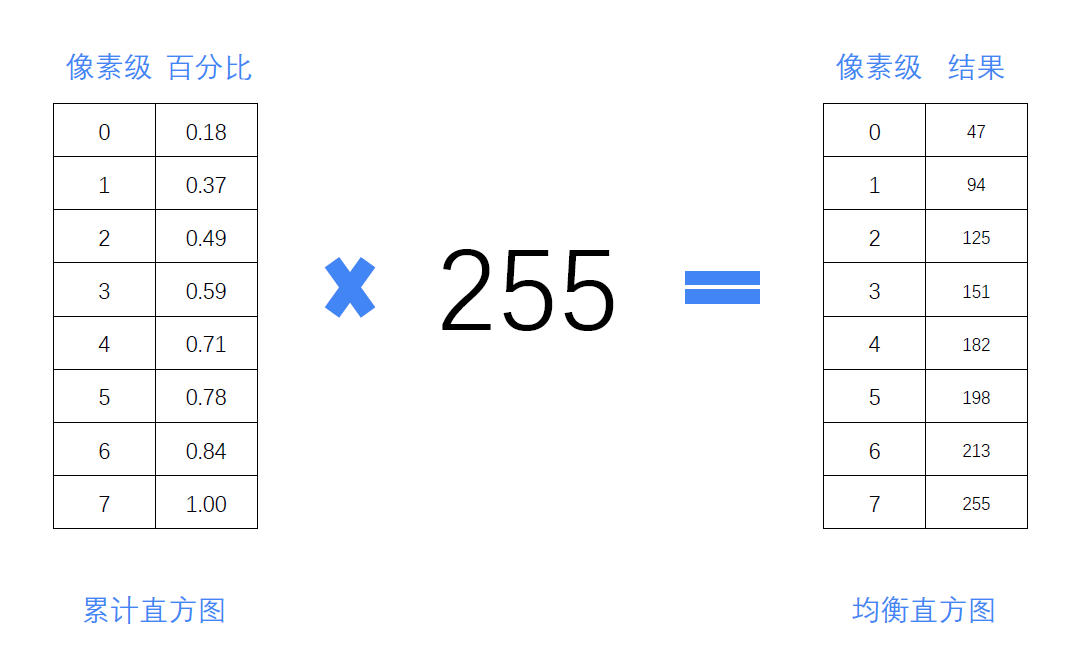
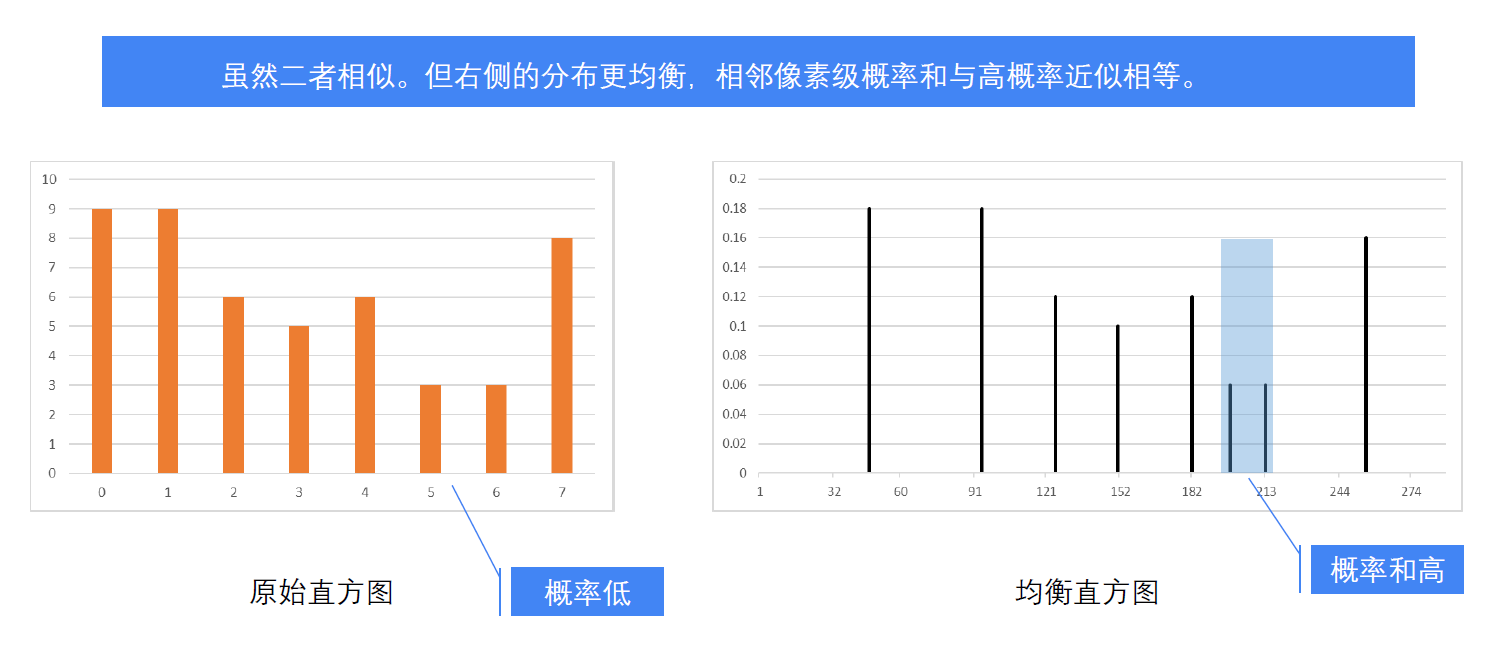
上述案例中,*255的例子虽然198和213的部分在整个直方图上看起来不均匀,但是由于这两块的值比较接近、颜色相近,肉眼会将它们视为一种颜色,因此统计直方图可以将这两部分视为一块,概率和放在这里在整个直方图上还是比较均匀的(简单来说,就是密集的地方概率小、稀疏的地方概率大)。
应用场景:
- 医疗图像处理
- 车牌识别
- 人脸识别
直方图均衡化
res = cv2.equalizeHist(img)
示例代码:
import cv2
import matplotlib.pyplot as plt
import numpy as np
'''读取、展示图像'''
img = cv2.imread("../001.jpg", cv2.IMREAD_GRAYSCALE)
cv2.imshow("origin", img)
'''直方图均衡化'''
equ = cv2.equalizeHist(img)
cv2.imshow("equ", equ)
'''绘制直方图'''
plt.hist(img.ravel(), 256)
plt.figure()
plt.hist(equ.ravel(), 256)
plt.show()
'''等待、关闭图像'''
cv2.waitKey(0)
cv2.destroyAllWindows()
效果:
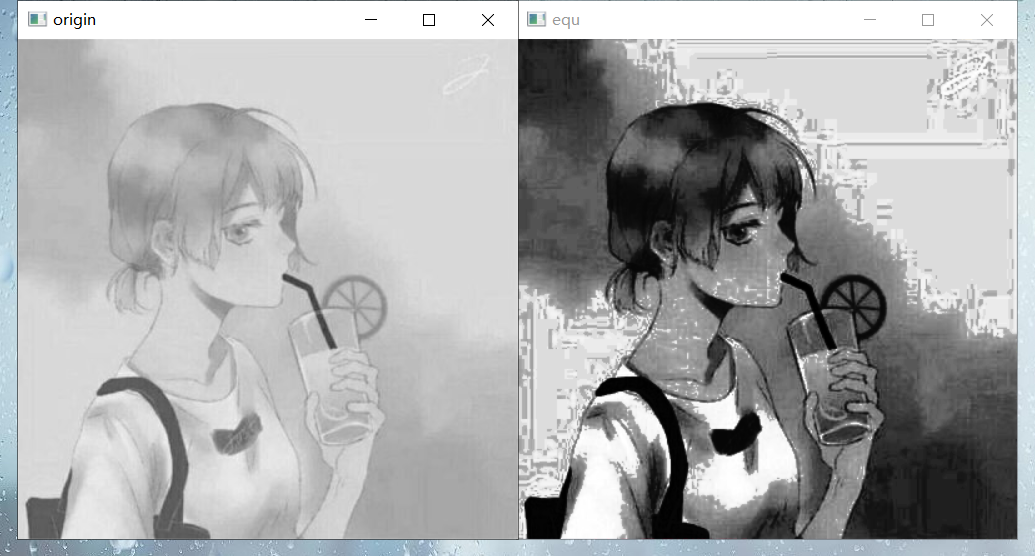
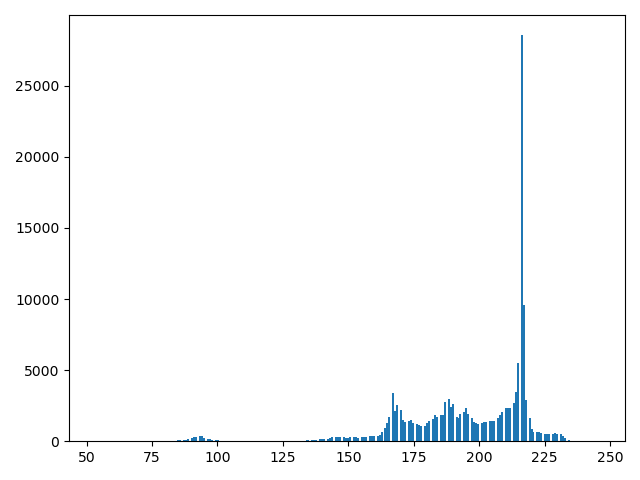
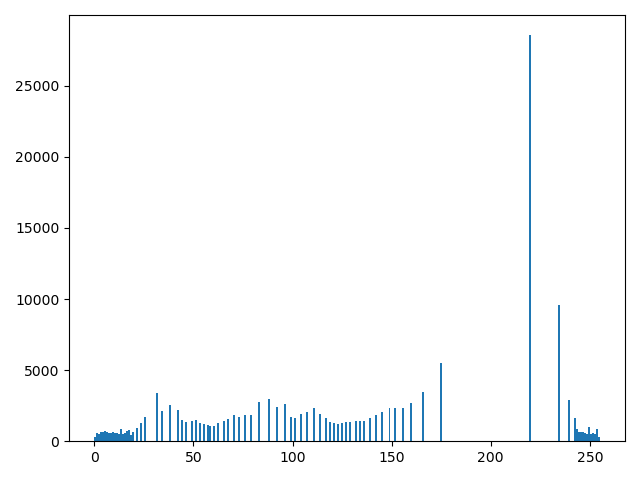
合并绘图
'''
分nrows行,ncols列,绘制第plot_number个
特殊地,当每一个参数都小于10时,可以直接将三个数字写在一起(如:subplot(234))
'''
subplot(nrows, ncols, plot_number)
plt绘图
'''
彩色图像:
cv2默认使用BGR通道
plt默认使用RGB通道
因此cv2读入的图像需要先进行通道调整才能用plt进行展示
灰度图像:
设置参数cmap=plt.cm.gray
'''
plt.imshow(img, camp=XXX)
示例代码:
import cv2
import matplotlib.pyplot as plt
import numpy as np
'''读取、展示图像'''
img = cv2.imread("../001.jpg", cv2.IMREAD_GRAYSCALE)
cv2.imshow("origin", img)
'''直方图均衡化'''
equ = cv2.equalizeHist(img)
cv2.imshow("equ", equ)
'''绘制直方图'''
plt.subplot(221)
plt.imshow(img, cmap=plt.cm.gray)
plt.axis('off')
plt.subplot(222)
plt.imshow(equ, cmap=plt.cm.gray)
plt.axis('off')
plt.subplot(223)
plt.hist(img.ravel(), 256)
plt.subplot(224)
plt.hist(equ.ravel(), 256)
plt.show()
'''等待、关闭图像'''
cv2.waitKey(0)
cv2.destroyAllWindows()
效果:
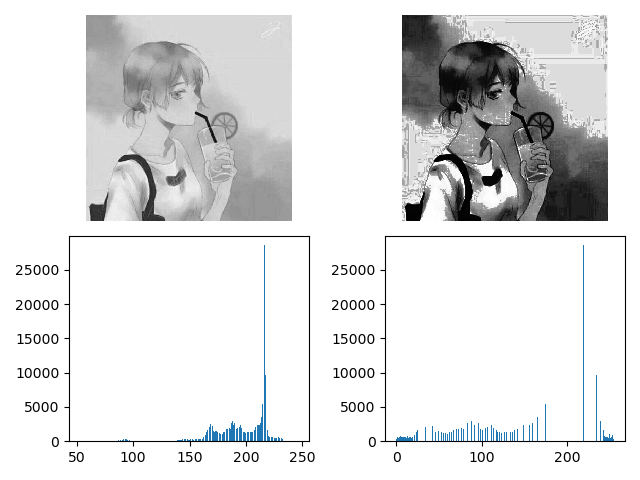
十四、傅里叶变换
1、傅里叶变换
任何连续周期信号,可以由一组适当的正弦曲线组合而成。
——傅里叶
一个正弦曲线可以等价于一组[频率, 振幅, 相位]
一个复杂的曲线也可以由多个正弦曲线组合而成
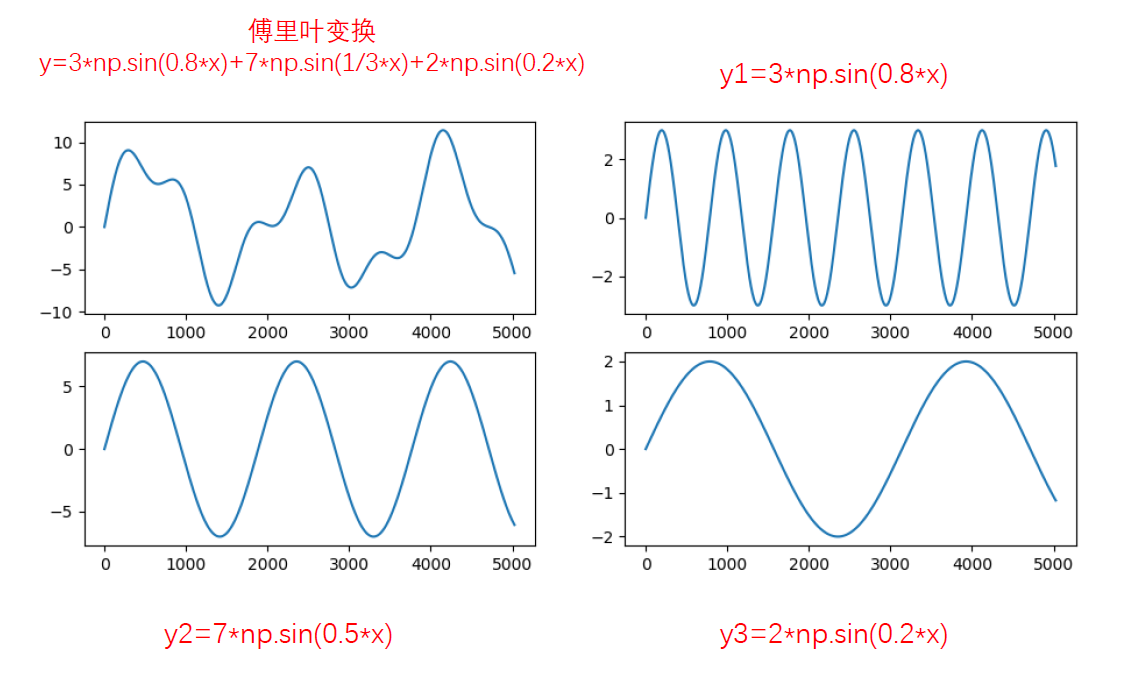
Tips:傅里叶变换是可逆的
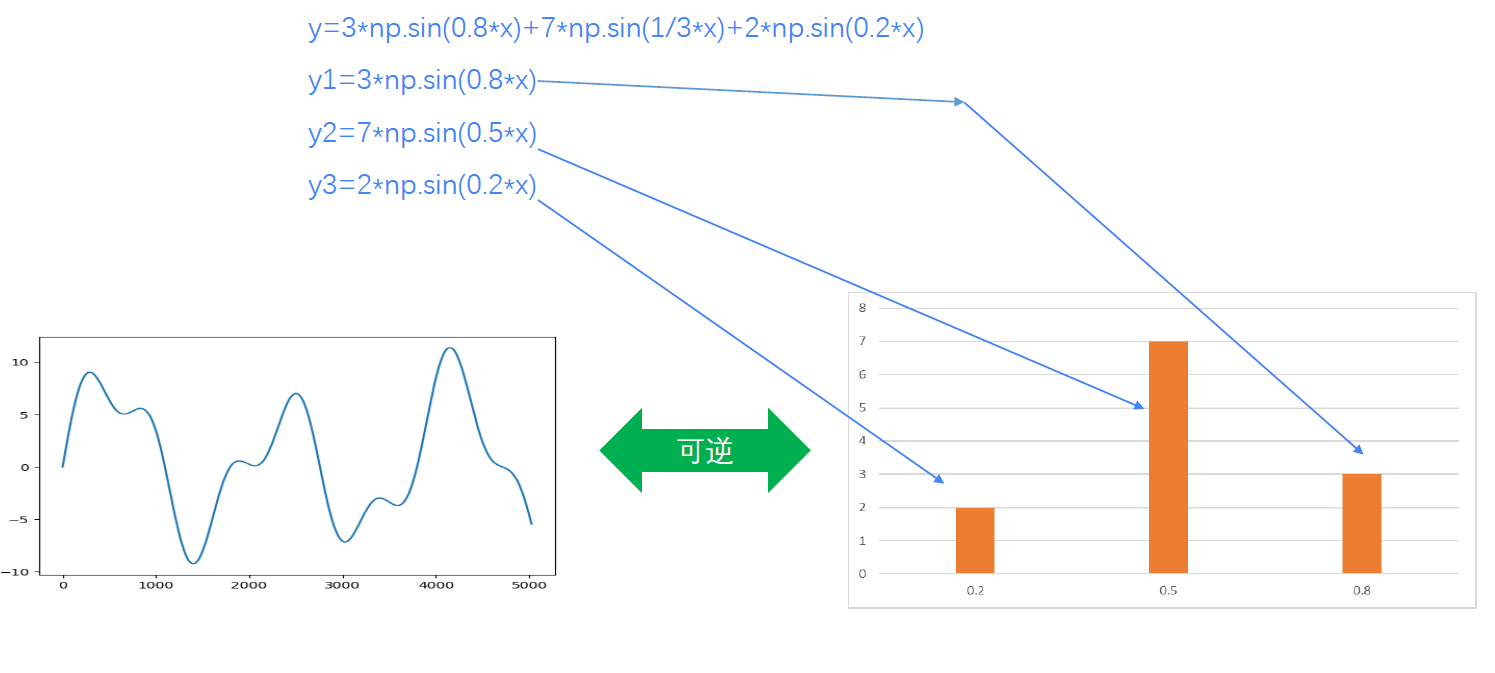
Tips:有时候开始的时间不一样,需要使用相位
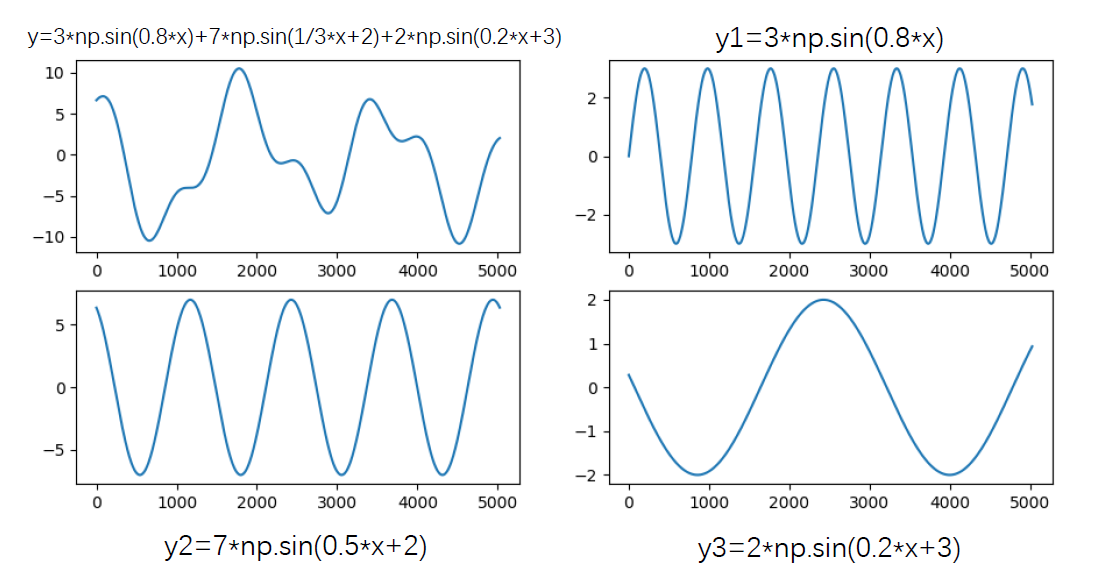
Tips:
- 傅里叶变换得到低频、高频信息,针对低频、高频处理能够实现不同的目的
- 傅里叶变换可逆,图像经过傅里叶变换、逆傅里叶变换后,能够恢复到原始图像
- 在频域对图像进行处理,会反映在逆变换的图像上
Numpy实现
# 实现傅里叶变换,得到复数数组
f = np.fft.fft2(img)
# 将低频移动到中心位置
f_shift = np.fft.fftshift(f)
# 将复数数组映射到0-255的像素数组
res = 20 * np.log(np.abs(f_shift))
示例代码:
import cv2
import matplotlib.pyplot as plt
import numpy as np
'''读取、展示图像'''
img = cv2.imread("../001.jpg", cv2.IMREAD_GRAYSCALE)
cv2.imshow("origin", img)
'''傅里叶变换'''
f = np.fft.fft2(img)
f_shift = np.fft.fftshift(f)
res = 20 * np.log(np.abs(f_shift))
'''绘图'''
plt.subplot(121)
plt.imshow(img, cmap="gray")
plt.axis("off")
plt.subplot(122)
plt.imshow(res, cmap="gray")
plt.axis("off")
plt.show()
'''等待、关闭图像'''
cv2.waitKey(0)
cv2.destroyAllWindows()
效果:

OpenCV实现
# 图像类型转换
img_32 = np.float32(img)
'''
傅里叶变换
f
双通道
第1个通道是结果的实数部分
第2个通道是结果的虚数部分
img_32
要求转换为np.float32格式:np.float32(img)
flags
一般使用cv2.DFT_COPLEX_OUTPUT,输出一个附属阵列
'''
f = cv2.dft(img_32, cv2.DFT_COMPLEX_OUTPUT)
f_shift = np.fft.fftshift(f)
# 计算幅值(其实就是计算复数的模)
f_abs = cv2.magnitude(f_shift[:,:,0],f_shift[:,:,1])
# 区间映射
f_res = 20 * np.log(f_abs)
示例代码:
import cv2
import matplotlib.pyplot as plt
import numpy as np
'''读取、展示图像'''
img = cv2.imread("../001.jpg", cv2.IMREAD_GRAYSCALE)
cv2.imshow("origin", img)
'''傅里叶变换'''
img_32 = np.float32(img)
f = cv2.dft(img_32, flags=cv2.DFT_COMPLEX_OUTPUT)
f_shift = np.fft.fftshift(f)
f_abs = cv2.magnitude(f_shift[:, :, 0], f_shift[:, :, 0])
res = 20 * np.log(f_abs + 1e-9)
'''绘图'''
plt.subplot(121)
plt.imshow(img, cmap="gray")
plt.axis("off")
plt.subplot(122)
plt.imshow(res, cmap="gray")
plt.axis("off")
plt.show()
'''等待、关闭图像'''
cv2.waitKey(0)
cv2.destroyAllWindows()
效果:
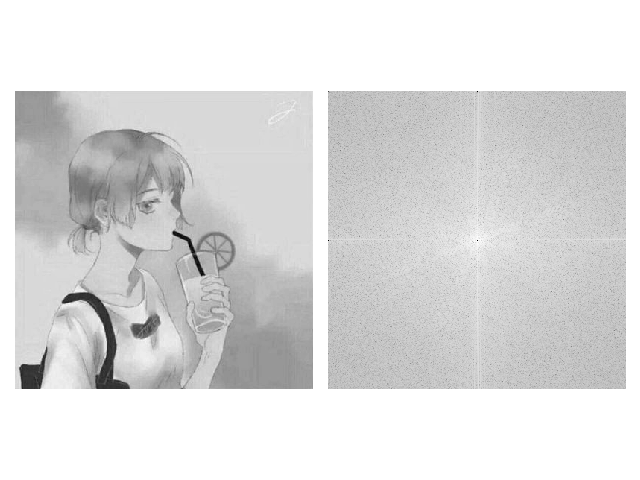
2、逆傅里叶变换
通过傅里叶变换,我们可以得到一个频谱
我们可以根据频谱对该频谱上特定的高频/低频处进行操作
通过逆傅里叶变换,我们可以把频谱还原为图像
Numpy实现
'''傅里叶变换'''
f = np.fft.fft2(img)
f_shift = np.fft.fftshift(f)
'''逆傅里叶变换'''
i_shift = np.fft.ifftshift(f_shift)
i = np.fft.ifft2(i_shift)
res = np.abs(i)
示例代码:
import cv2
import matplotlib.pyplot as plt
import numpy as np
'''读取、展示图像'''
img = cv2.imread("../001.jpg", cv2.IMREAD_GRAYSCALE)
cv2.imshow("origin", img)
'''傅里叶变换'''
f = np.fft.fft2(img)
f_shift = np.fft.fftshift(f)
res_f = 20 * np.log(np.abs(f_shift))
'''逆傅里叶变换'''
i_shift = np.fft.ifftshift(f_shift)
i = np.fft.ifft2(i_shift)
res_i = np.abs(i)
'''绘图'''
plt.subplot(131)
plt.imshow(img, cmap="gray")
plt.title("origin")
plt.axis("off")
plt.subplot(132)
plt.imshow(res_f, cmap="gray")
plt.title("fourier")
plt.axis("off")
plt.subplot(133)
plt.imshow(res_i, cmap="gray")
plt.title("inverse fourier")
plt.axis("off")
plt.show()
'''等待、关闭图像'''
cv2.waitKey(0)
cv2.destroyAllWindows()
效果:
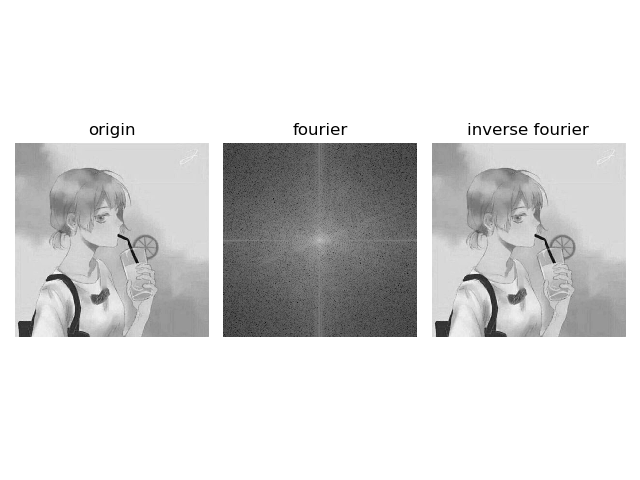
OpenCV实现
'''傅里叶变换'''
img_32 = np.float32(img)
f = cv2.dft(img_32, cv2.DFT_COMPLEX_OUTPUT)
f_shift = np.fft.fftshift(f)
'''逆傅里叶变换'''
i_shift = np.fft.ifftshift(f_shift)
i = cv2.idft(i_shift)
res_i = cv2.magnitude(i[:, :, 0], i[:, :, 1])
示例代码:
import cv2
import matplotlib.pyplot as plt
import numpy as np
'''读取、展示图像'''
img = cv2.imread("../001.jpg", cv2.IMREAD_GRAYSCALE)
cv2.imshow("origin", img)
'''傅里叶变换'''
img_32 = np.float32(img)
f = cv2.dft(img_32, flags=cv2.DFT_COMPLEX_OUTPUT)
f_shift = np.fft.fftshift(f)
f_abs = cv2.magnitude(f_shift[:, :, 0], f_shift[:, :, 0])
f_res = 20 * np.log(f_abs + 1e-9)
'''逆傅里叶变换'''
i_shift = np.fft.ifftshift(f_shift)
i = cv2.idft(i_shift)
i_res = cv2.magnitude(i[:, :, 0], i[:, :, 1])
'''绘图'''
plt.subplot(131)
plt.imshow(img, cmap="gray")
plt.title("origin")
plt.axis("off")
plt.subplot(132)
plt.imshow(f_res, cmap="gray")
plt.title("fourier")
plt.axis("off")
plt.subplot(133)
plt.imshow(i_res, cmap="gray")
plt.title("inverse fourier")
plt.axis("off")
plt.show()
'''等待、关闭图像'''
cv2.waitKey(0)
cv2.destroyAllWindows()
效果:

3、滤波
(1).滤波
低频对应图像内变化缓慢的灰度分量(如:大草原的图像中,颜色趋于一致的草原)
高频对应图像内变化越来越快的灰度分量,由灰度的尖锐过度造成(如:大草原的图像中,狮子的边缘等信息)
滤波
- 通过/拒绝一定频率的分量
- 通过低频的滤波器称为低通滤波器
低通滤波器将会模糊一些图像 - 通过高频的滤波器称为高通滤波器
高通滤波器将会增强图像中尖锐的细节,但会导致图像的对比度降低
频域滤波
先进行傅里叶变换得到图像的高频/低频信息,对其进行处理,再进行逆傅里叶变换还原为图像,以达到特殊目的:
- 图像增强
- 图像去噪
- 边缘检测
- 特征提取
- 压缩
- 加密
- ……
(2).高通滤波
高通滤波
rows, cols = img.shape
crow, ccol = rows // 2, cols // 2
f_shift[crow - 30:crow + 30, ccol - 30:ccol + 30] = 0
示例代码(Numpy):
import cv2
import matplotlib.pyplot as plt
import numpy as np
'''读取、展示图像'''
img = cv2.imread("../001.jpg", cv2.IMREAD_GRAYSCALE)
cv2.imshow("origin", img)
'''傅里叶变换'''
f = np.fft.fft2(img)
f_shift = np.fft.fftshift(f)
res_f = 20 * np.log(np.abs(f_shift))
'''高通滤波'''
rows, cols = img.shape
crow, ccol = rows // 2, cols // 2
f_shift[crow - 30:crow + 30, ccol - 30:ccol + 30] = 0
res_f2 = 20 * np.log(np.abs(f_shift) + 1e-9)
'''逆傅里叶变换'''
i_shift = np.fft.ifftshift(f_shift)
i = np.fft.ifft2(i_shift)
res_i = np.abs(i)
res_i = np.uint8(res_i / res_i.max() * 256)
cv2.imshow("res", res_i)
'''绘图'''
plt.subplot(221)
plt.imshow(img, cmap="gray")
plt.title("origin")
plt.axis("off")
plt.subplot(222)
plt.imshow(res_f, cmap="gray")
plt.title("fourier")
plt.axis("off")
plt.subplot(223)
plt.imshow(res_f2, cmap="gray")
plt.title("high-pass-filter")
plt.axis("off")
plt.subplot(224)
plt.imshow(res_i, cmap="gray")
plt.title("inverse fourier")
plt.axis("off")
plt.show()
'''等待、关闭图像'''
cv2.waitKey(0)
cv2.destroyAllWindows()
效果:
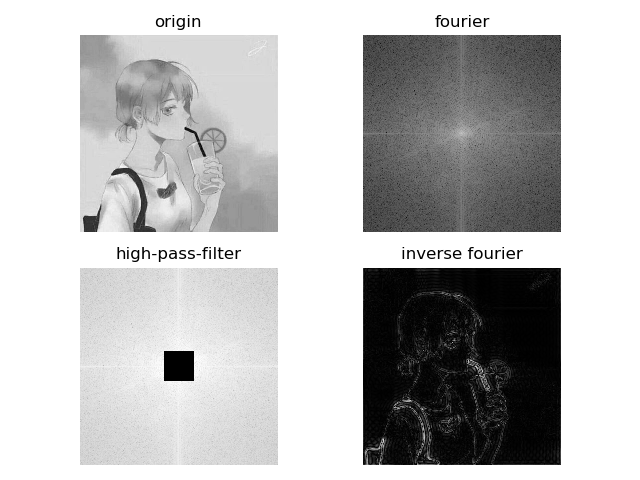

示例代码(OpenCV):
import cv2
import matplotlib.pyplot as plt
import numpy as np
'''读取、展示图像'''
img = cv2.imread("../001.jpg", cv2.IMREAD_GRAYSCALE)
cv2.imshow("origin", img)
'''傅里叶变换'''
img_32 = np.float32(img)
f = cv2.dft(img_32, flags=cv2.DFT_COMPLEX_OUTPUT)
f_shift = np.fft.fftshift(f)
f_abs = cv2.magnitude(f_shift[:, :, 0], f_shift[:, :, 1])
res_f = 20 * np.log(f_abs)
'''高通滤波'''
rows, cols = img.shape
crow, ccol = rows // 2, cols // 2
f_shift[crow - 30:crow + 30, ccol - 30:ccol + 30, :] = 0
f_abs2 = cv2.magnitude(f_shift[:, :, 0], f_shift[:, :, 1])
res_f2 = 20 * np.log(f_abs2 + 1e-9)
'''逆傅里叶变换'''
i_shift = np.fft.ifftshift(f_shift)
i = cv2.idft(i_shift)
res_i = cv2.magnitude(i[:, :, 0], i[:, :, 1])
res_i = np.uint8(res_i / res_i.max() * 256)
cv2.imshow("res", res_i)
'''绘图'''
plt.subplot(221)
plt.imshow(img, cmap="gray")
plt.title("origin")
plt.axis("off")
plt.subplot(222)
plt.imshow(res_f, cmap="gray")
plt.title("fourier")
plt.axis("off")
plt.subplot(223)
plt.imshow(res_f2, cmap="gray")
plt.title("high-pass-filter")
plt.axis("off")
plt.subplot(224)
plt.imshow(res_i, cmap="gray")
plt.title("inverse fourier")
plt.axis("off")
plt.show()
'''等待、关闭图像'''
cv2.waitKey(0)
cv2.destroyAllWindows()
效果:
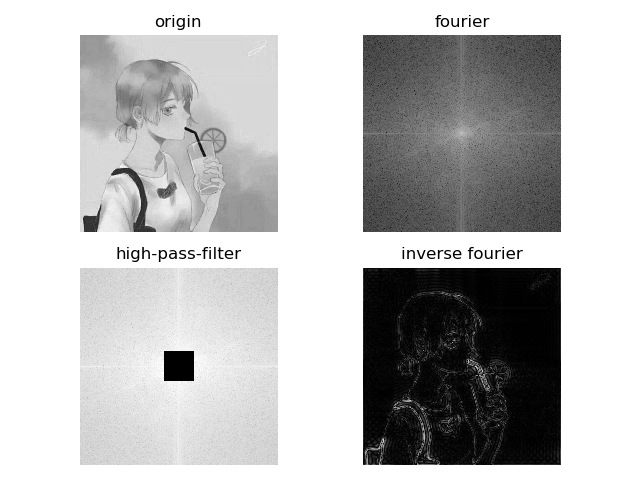
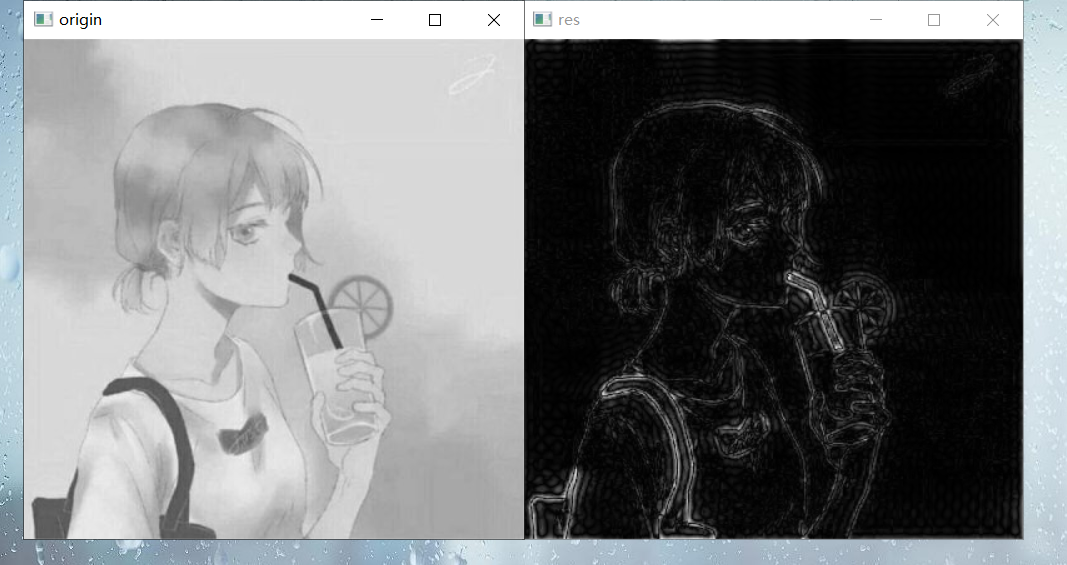
(3).低通滤波
低通滤波
rows, cols = img.shape
crow, ccol = rows // 2, cols // 2
mask = np.zeros((rows, cols, 2), np.uint8)
mask[crow - 30:crow + 30, ccol - 30:ccol + 30] = 1
f_shift *= mask
示例代码(Numpy):
import cv2
import matplotlib.pyplot as plt
import numpy as np
'''读取、展示图像'''
img = cv2.imread("../001.jpg", cv2.IMREAD_GRAYSCALE)
cv2.imshow("origin", img)
'''傅里叶变换'''
f = np.fft.fft2(img)
f_shift = np.fft.fftshift(f)
res_f = 20 * np.log(np.abs(f_shift))
'''低通滤波'''
rows, cols = img.shape
crow, ccol = rows // 2, cols // 2
mask = np.zeros((rows, cols), np.uint8)
mask[crow - 30:crow + 30, ccol - 30:ccol + 30] = 1
f_shift *= mask
res_f2 = 20 * np.log(np.abs(f_shift) + 1e-9)
'''逆傅里叶变换'''
i_shift = np.fft.ifftshift(f_shift)
i = np.fft.ifft2(i_shift)
res_i = np.abs(i)
res_i = np.uint8(res_i / res_i.max() * 256)
cv2.imshow("res", res_i)
'''绘图'''
plt.subplot(221)
plt.imshow(img, cmap="gray")
plt.title("origin")
plt.axis("off")
plt.subplot(222)
plt.imshow(res_f, cmap="gray")
plt.title("fourier")
plt.axis("off")
plt.subplot(223)
plt.imshow(res_f2, cmap="gray")
plt.title("high-pass-filter")
plt.axis("off")
plt.subplot(224)
plt.imshow(res_i, cmap="gray")
plt.title("inverse fourier")
plt.axis("off")
plt.show()
'''等待、关闭图像'''
cv2.waitKey(0)
cv2.destroyAllWindows()
效果:

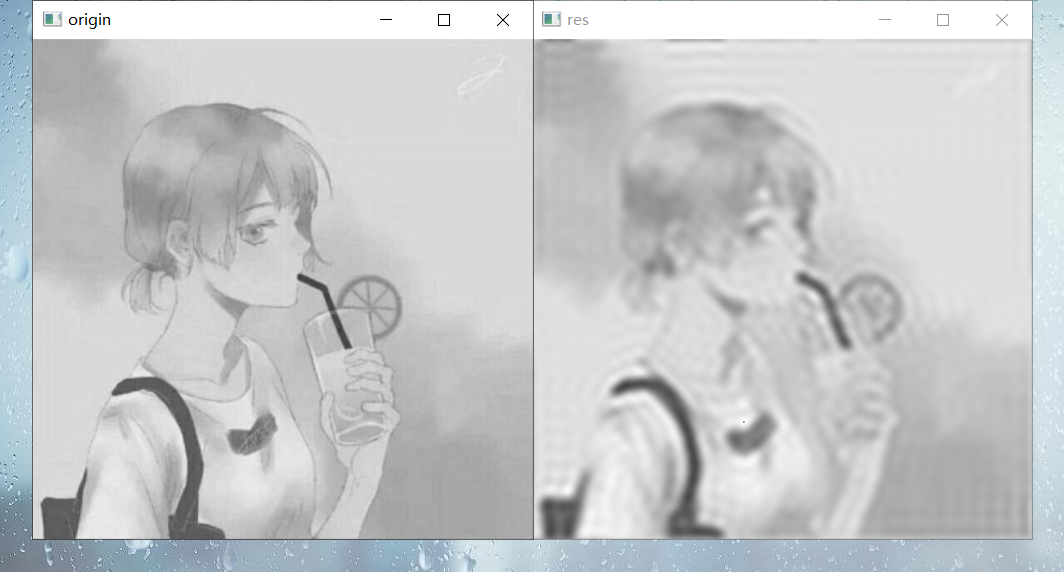
示例代码(OpenCV):
import cv2
import matplotlib.pyplot as plt
import numpy as np
'''读取、展示图像'''
img = cv2.imread("../001.jpg", cv2.IMREAD_GRAYSCALE)
cv2.imshow("origin", img)
'''傅里叶变换'''
img_32 = np.float32(img)
f = cv2.dft(img_32, flags=cv2.DFT_COMPLEX_OUTPUT)
f_shift = np.fft.fftshift(f)
f_abs = cv2.magnitude(f_shift[:, :, 0], f_shift[:, :, 1])
res_f = 20 * np.log(f_abs)
'''高通滤波'''
rows, cols = img.shape
crow, ccol = rows // 2, cols // 2
mask = np.zeros((rows, cols, 2), np.uint8)
mask[crow - 30:crow + 30, ccol - 30:ccol + 30, :] = 1
f_shift *= mask
f_abs2 = cv2.magnitude(f_shift[:, :, 0], f_shift[:, :, 1])
res_f2 = 20 * np.log(f_abs2 + 1e-9)
'''逆傅里叶变换'''
i_shift = np.fft.ifftshift(f_shift)
i = cv2.idft(i_shift)
res_i = cv2.magnitude(i[:, :, 0], i[:, :, 1])
res_i = np.uint8(res_i / res_i.max() * 256)
cv2.imshow("res", res_i)
'''绘图'''
plt.subplot(221)
plt.imshow(img, cmap="gray")
plt.title("origin")
plt.axis("off")
plt.subplot(222)
plt.imshow(res_f, cmap="gray")
plt.title("fourier")
plt.axis("off")
plt.subplot(223)
plt.imshow(res_f2, cmap="gray")
plt.title("high-pass-filter")
plt.axis("off")
plt.subplot(224)
plt.imshow(res_i, cmap="gray")
plt.title("inverse fourier")
plt.axis("off")
plt.show()
'''等待、关闭图像'''
cv2.waitKey(0)
cv2.destroyAllWindows()
效果:
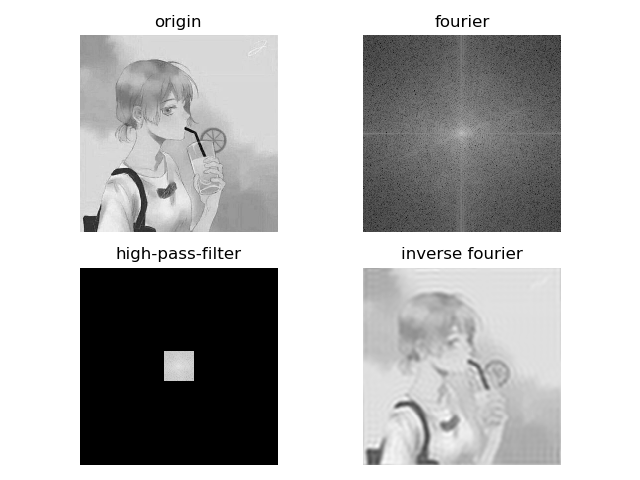
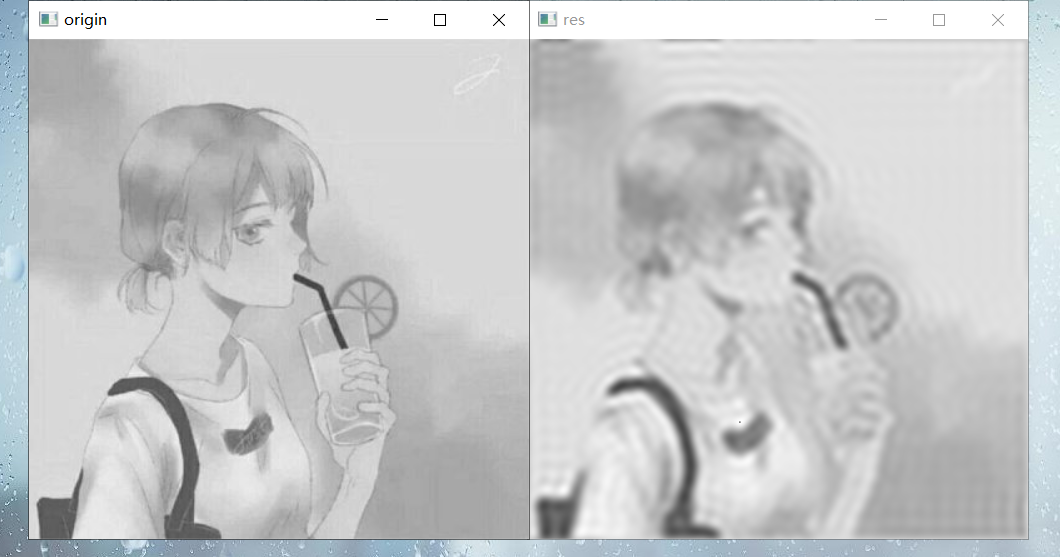
























 1159
1159











 被折叠的 条评论
为什么被折叠?
被折叠的 条评论
为什么被折叠?










